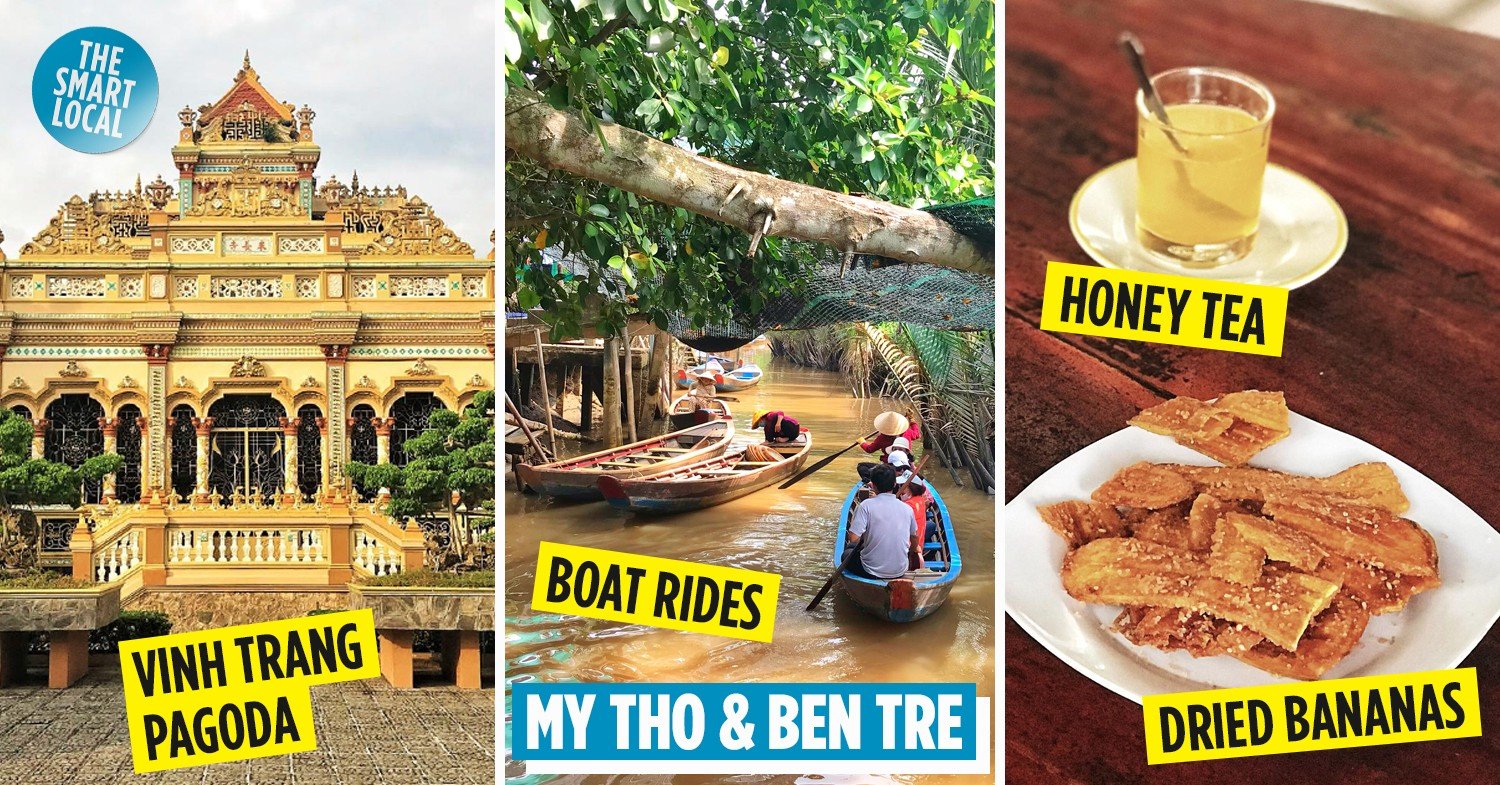Mỹ Tho and Bến Tre’s places of interest
Awash with greenery, islands, and with houses floating on its rivers, the Mekong Delta region is home to breathtaking landscapes and remarkable culture. To fully see and admire the lifestyles in various parts of the Mekong Delta, one usually needs 3 to 4 days.
However, those who have only one day to spend can choose to visit the quaint towns of Mỹ Tho and Bến Tre, which are right next to each other. Here’s what you can do in Mỹ Tho and Bến Tre for a scenic Mekong Delta weekend trip.
Mỹ Tho and Bến Tre

Mỹ Tho city as seen from the Tien River
Mỹ Tho is a city located in Tiền Giang Province, surrounded by the vast Tiền and Hậu rivers, Mỹ Tho is famed for its endless canals banked with towering coconut trees and fruit gardens, a common sight in the Mekong Delta, especially in popular imagination.
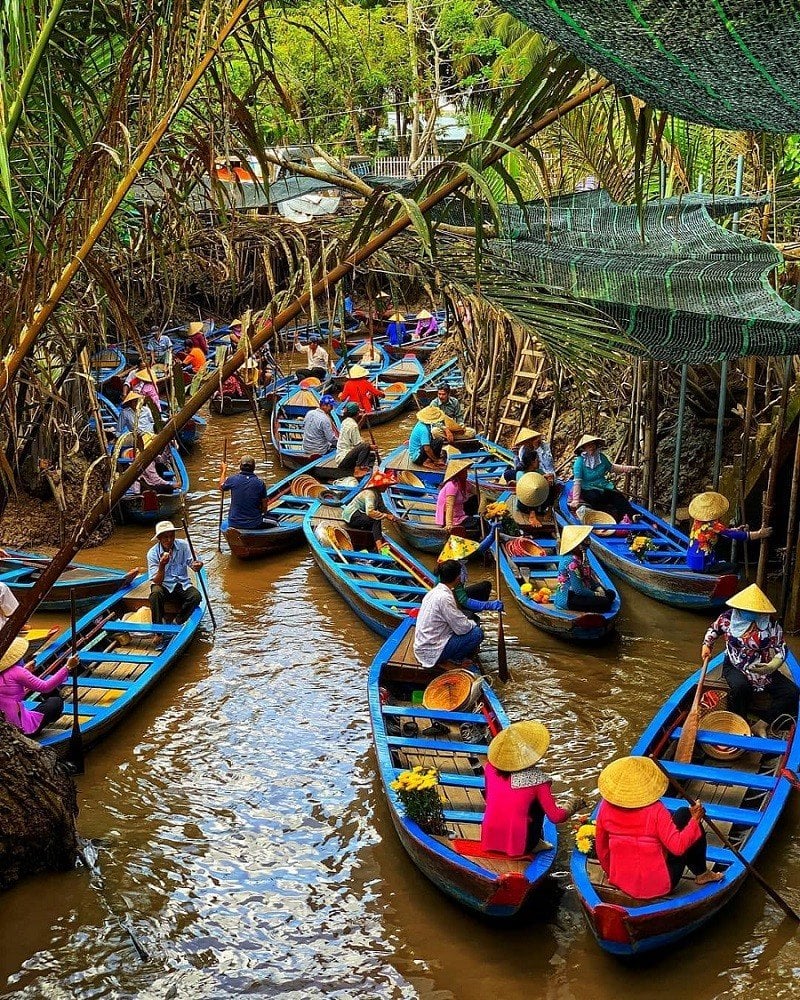
Image credit: @itstaduuh
The capital city of Bến Tre Province, the picturesque Bến Tre is adjacent to Mỹ Tho and nicknamed “the land of coconuts” because of its great numbers of coconut trees.
As they are only 13KM from each other, they make an easy day trip from Saigon for those looking to escape from the city.
How to get to Mỹ Tho from Saigon
The travel time from Saigon to Mỹ Tho City is only 2 hours. You can take a bus, which usually has 20-28 passengers, or a van, which can hold 7 to 10 passengers, depending on your preference.
Van
You can take a limousine van from Saigon to Mỹ Tho with Nam Á Châu Tourist Agency departing from 203 Pham Ngu Lao in Saigon’s District 1. The van will drop you off at its Mỹ Tho office on 30/4 Street.
A one-way ride ticket is at VND150,000 (~USD6.48) per person.
Bus
You can take a Samco bus which has plenty of pick-up points across Saigon’s District 5 for your convenience.
You can wait for the bus at locations such as 108-124 Tản Đà, Parkson Hùng Vương, Chợ Rẫy Hospital, Garden Mall, and Phú Lâm Roundabout.
The bus will drop you off at its Mỹ Tho office at 249 Nguyễn Thị Thập in Mỹ Tho Province.
For more information on pick-up and drop-off points, check out Samco’s detailed itinerary. A one-way ride ticket with Samco starts from VND65,000 (~USD2.81) per person.
How to reach Mekong Delta’s most iconic islands from downtown Mỹ Tho
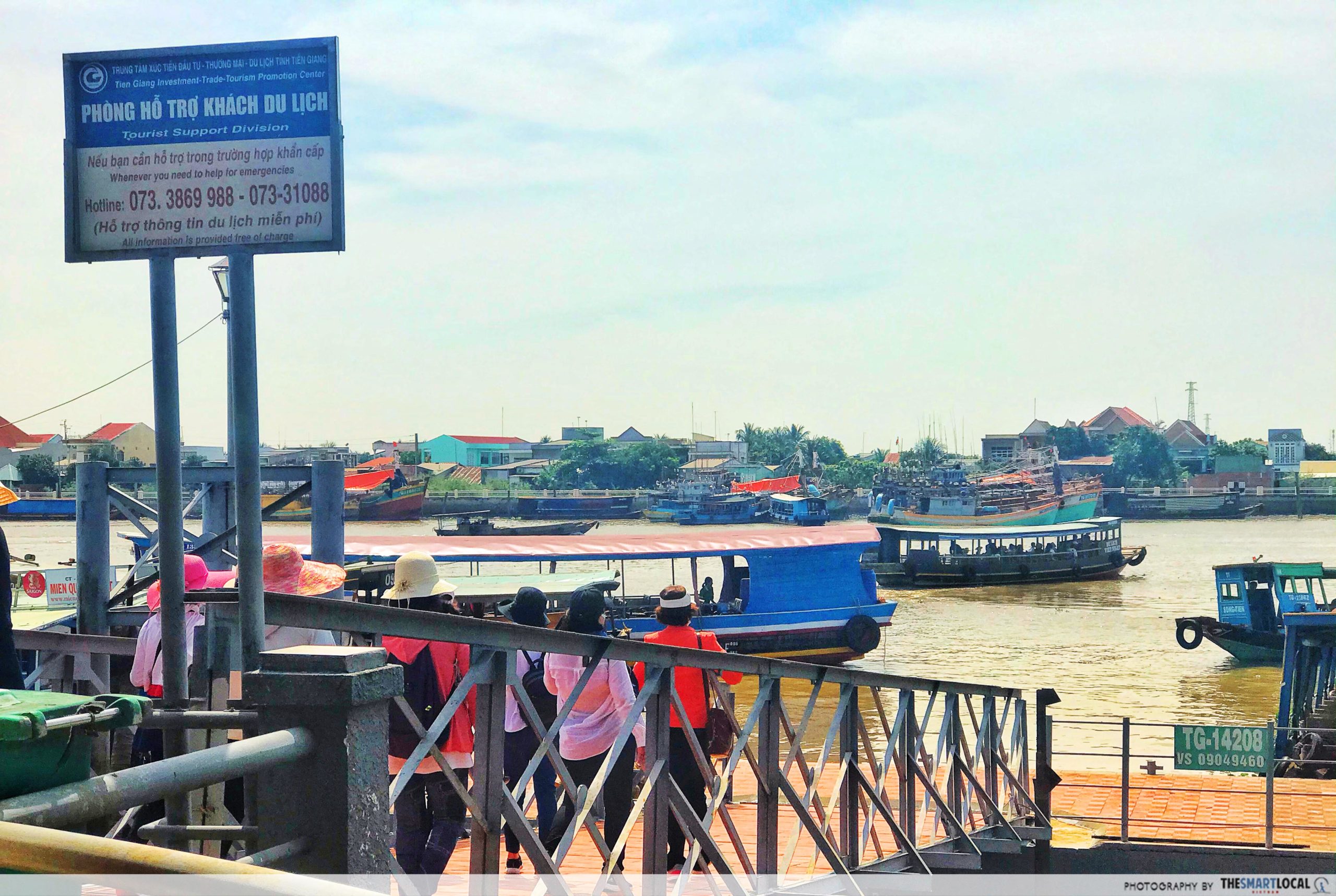
30/4 Boat Quay
Next, you’ll need to take a boat to the most famous islands of the Mekong Delta Region – Long (Dragon) Islands, Lân (Unicorn) Islands, Quy (Turtle) Islands, and Phụng (Phoenix) Islands. From the van or bus drop-off points, take a cab for a 5-minute ride or walk to the 30/4 Boat Quay.
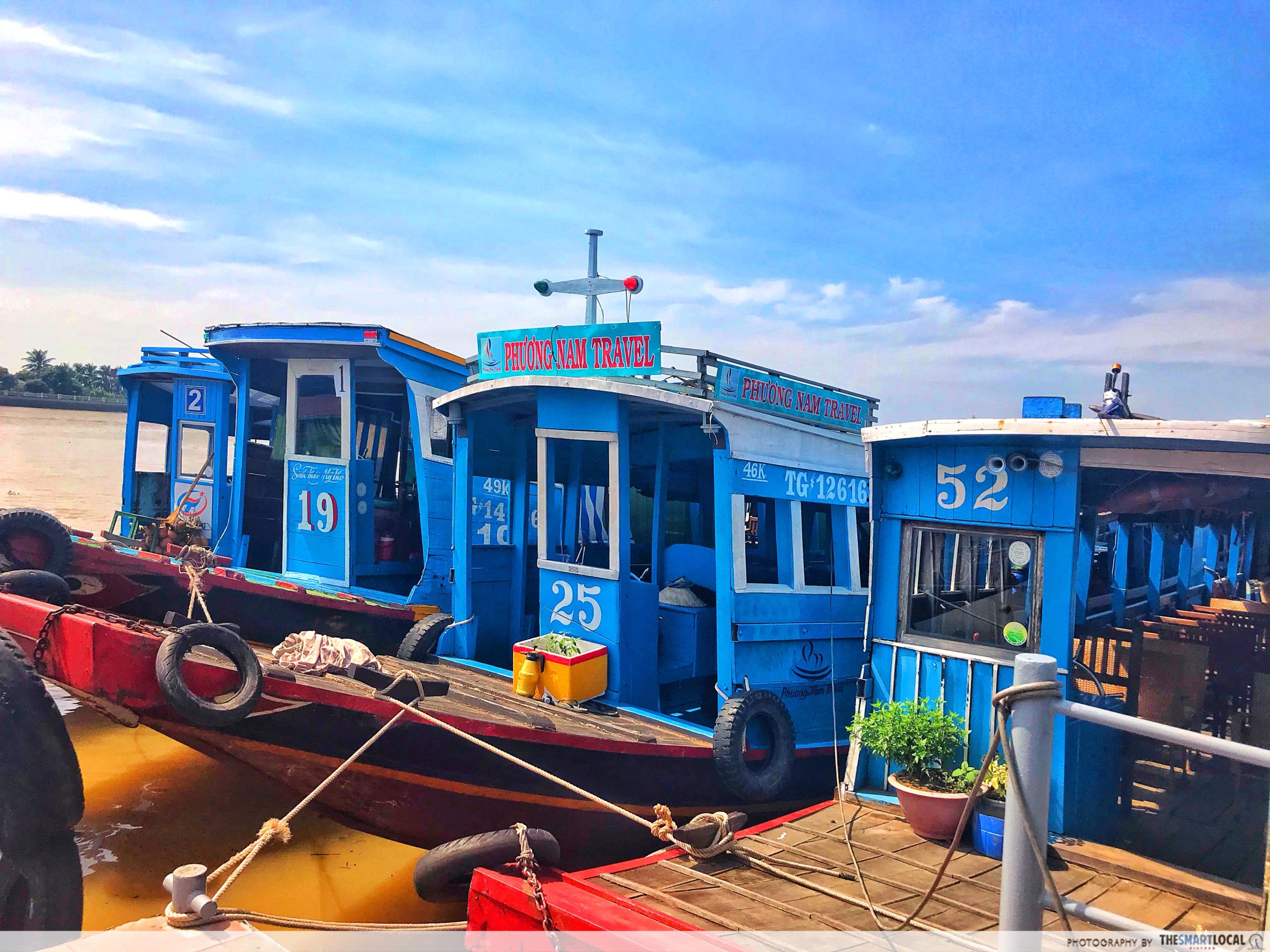
Visitors take these boats to the surrounding islands
Note: Most of the passengers traveling from the quay have bought tickets to book the whole boat. If you’re not with any organized tour, you might want to negotiate the price of your ticket with the captain.
The more passengers are on a boat, the lower the ticket price per person. In case you’re the only one traveling on a boat, you will have to pay a higher price for your boat ride.
Enjoy a relaxing boat ride on the Tien River
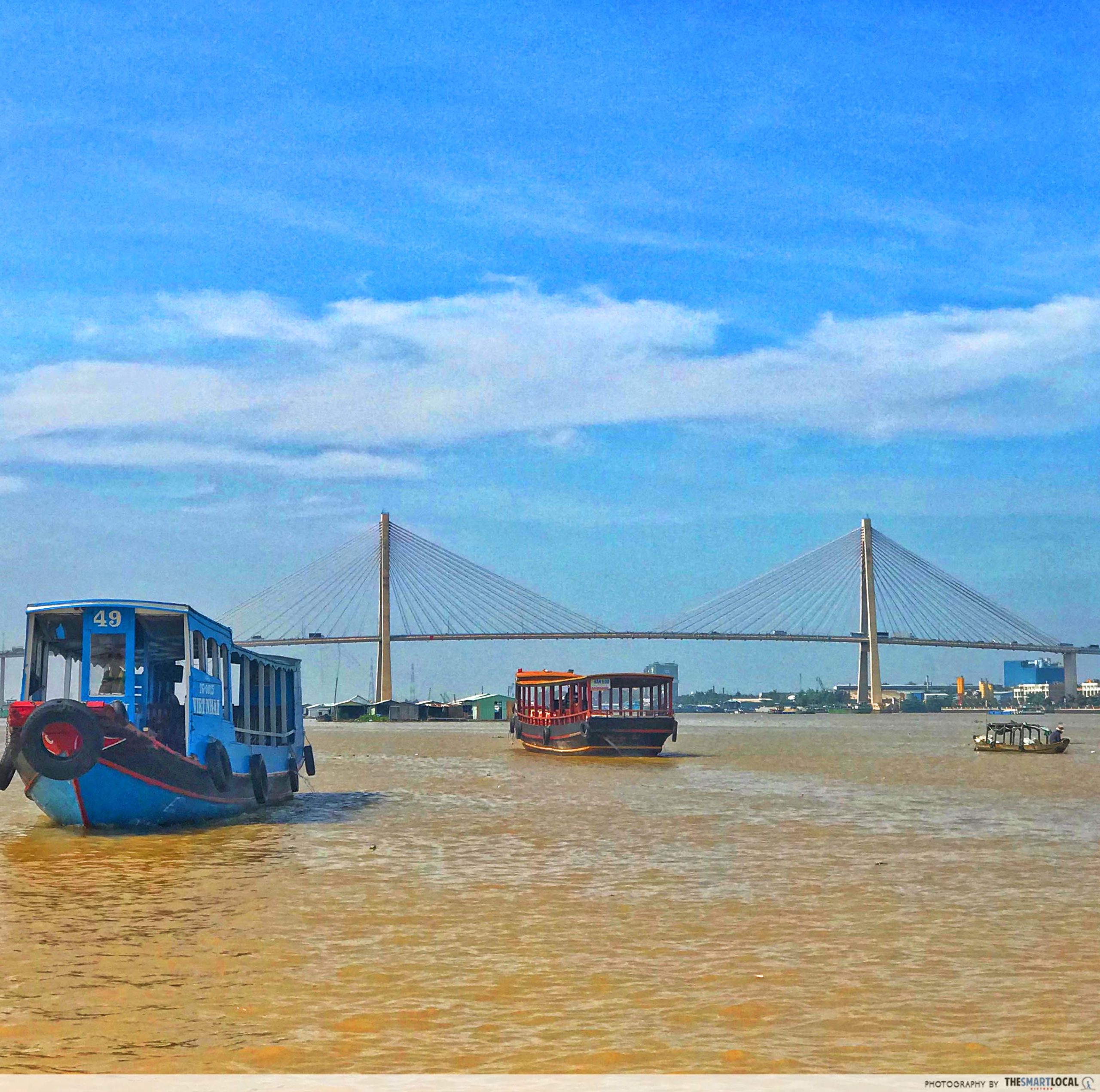
The Tiền River
The boat will take you on a ride around the Tiền River, the largest river of Tiền Giang Province.
From your seat, you’ll catch sight of Rạch Miễu bridge, a 8,331-long cable-stayed bridge that connects Tiền Giang Province with Bến Tre Province.
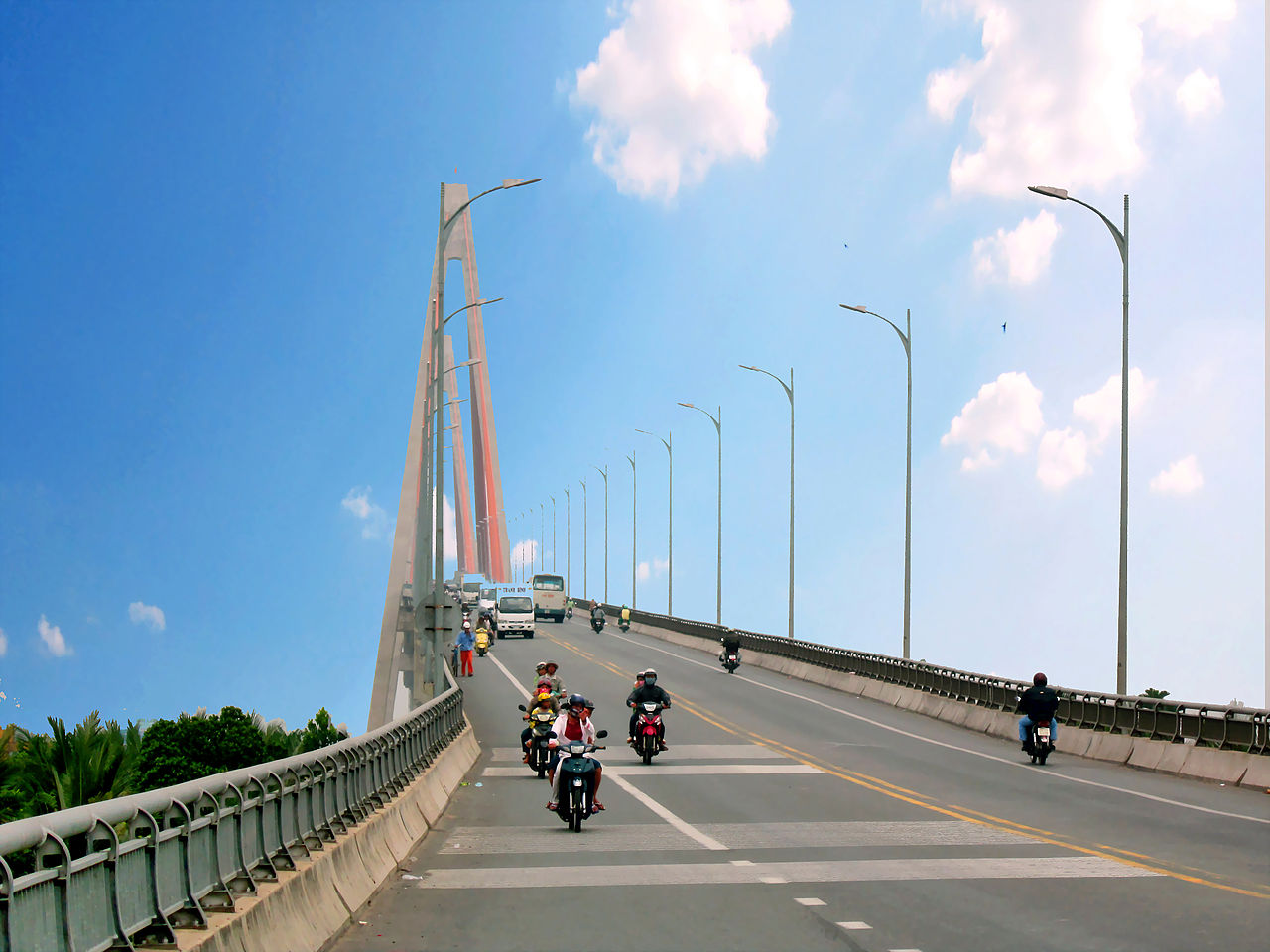
Image credit: Bùi Thụy Đào Nguyên/Wikimedia Commons
You’ll also catch a glimpse of the most famous islands of the Mekong Delta Region – Long (Dragon) Islands, Lân (Unicorn) Islands, Quy (Turtle) Islands, and Phụng (Phoenix) Islands, all awash with towering trees and gorgeous flowers.
Aside from the city of Mỹ Tho on the banks of the river, you’ll also find numerous floating fish farms.
Sip on honey tea and munch on dried bananas on Thới Sơn Island
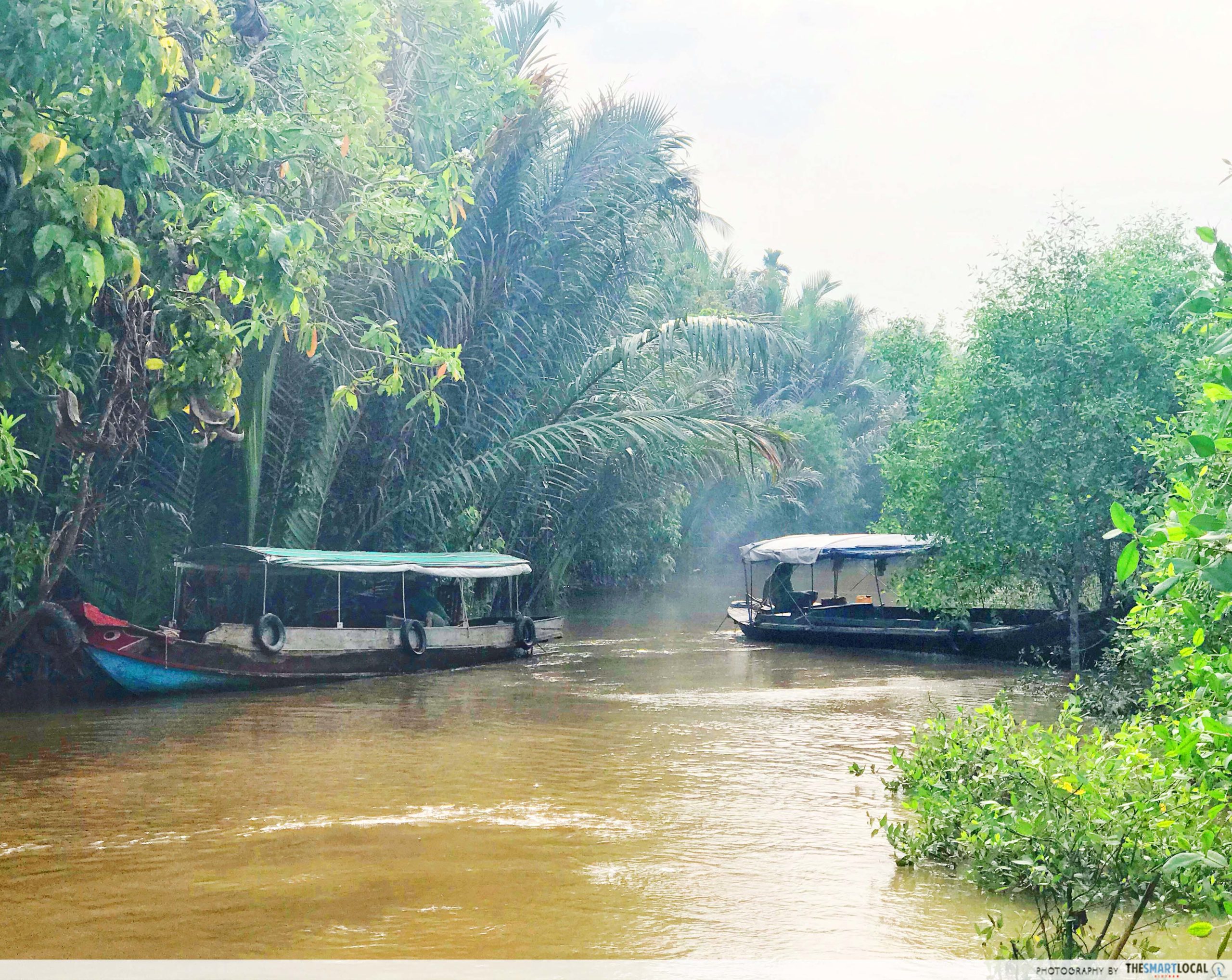
Thới Sơn Island
Of all the 4 islands, Lan Islands, also known as Thới Sơn Islands, is the most visited one because of its larger size and plenty of fun activities for visitors to engage in.
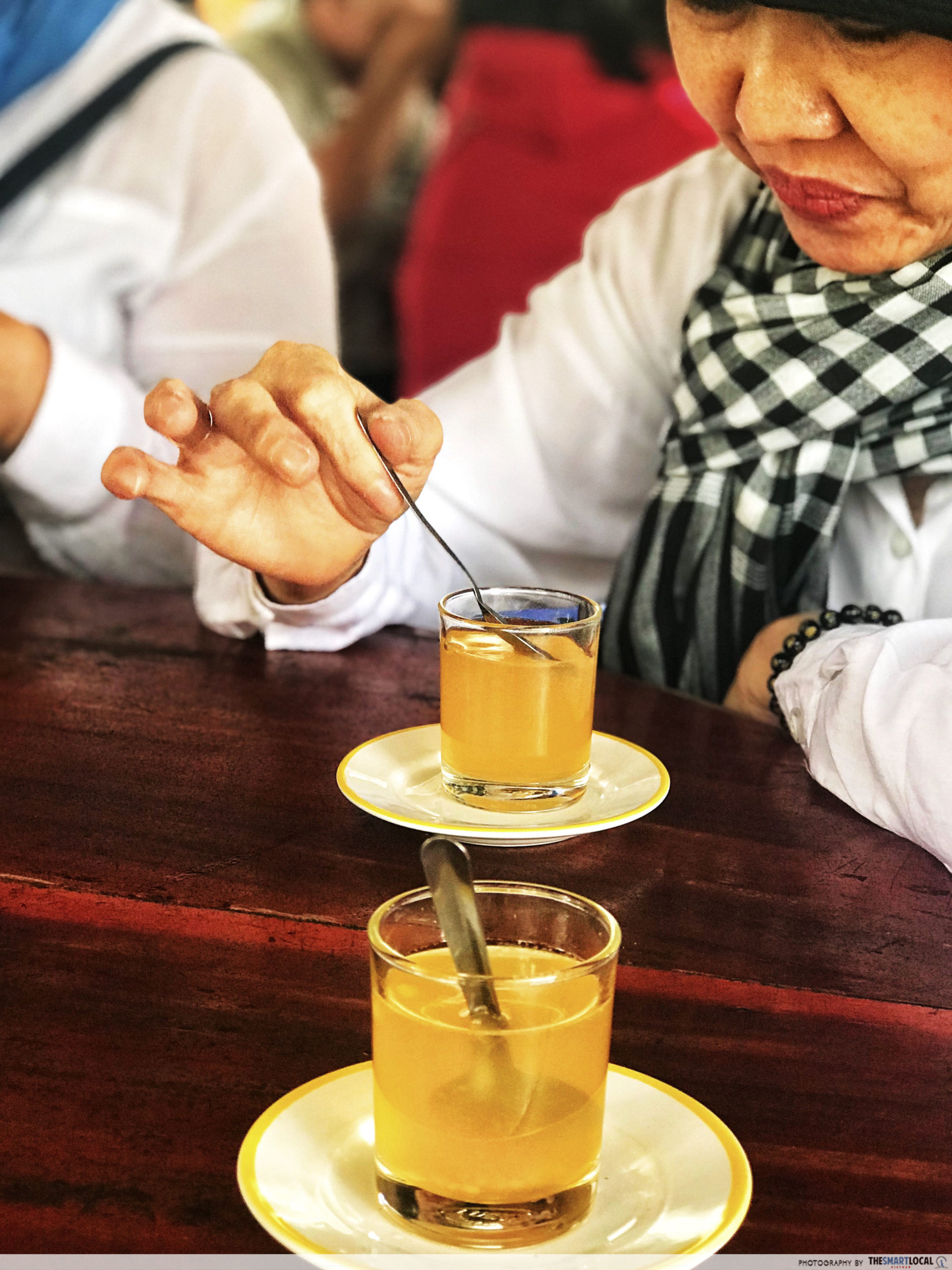
Upon reaching Thới Sơn Island, you’ll walk into a rustic and quaint A-frame roofed house built from bamboo, a charming architectural structure commonly found only in the Mekong Delta region.
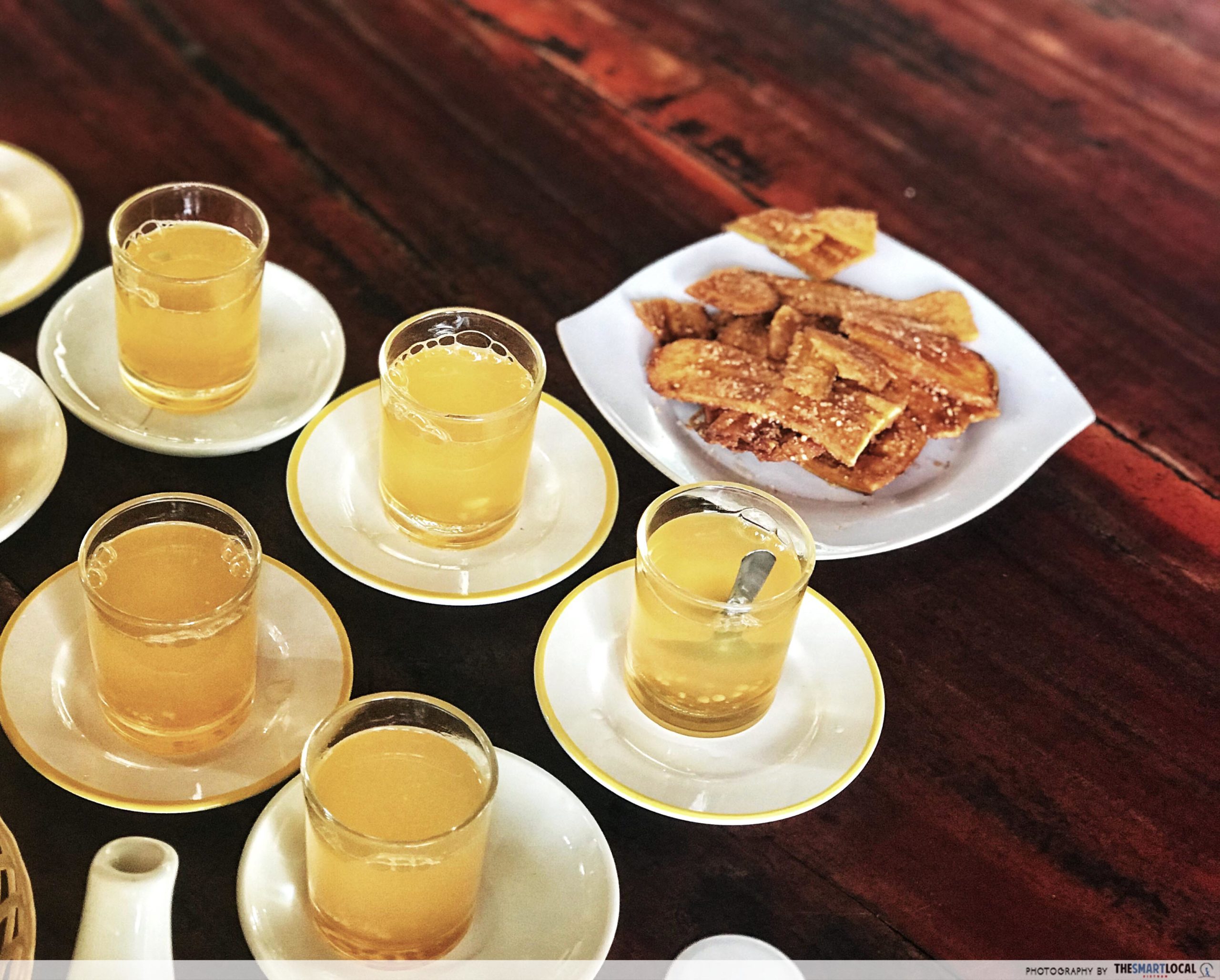
Sit down and recharge your batteries over some sweet and crunchy dried bananas and sweet and sour honey tea, which are the region’s specialties.
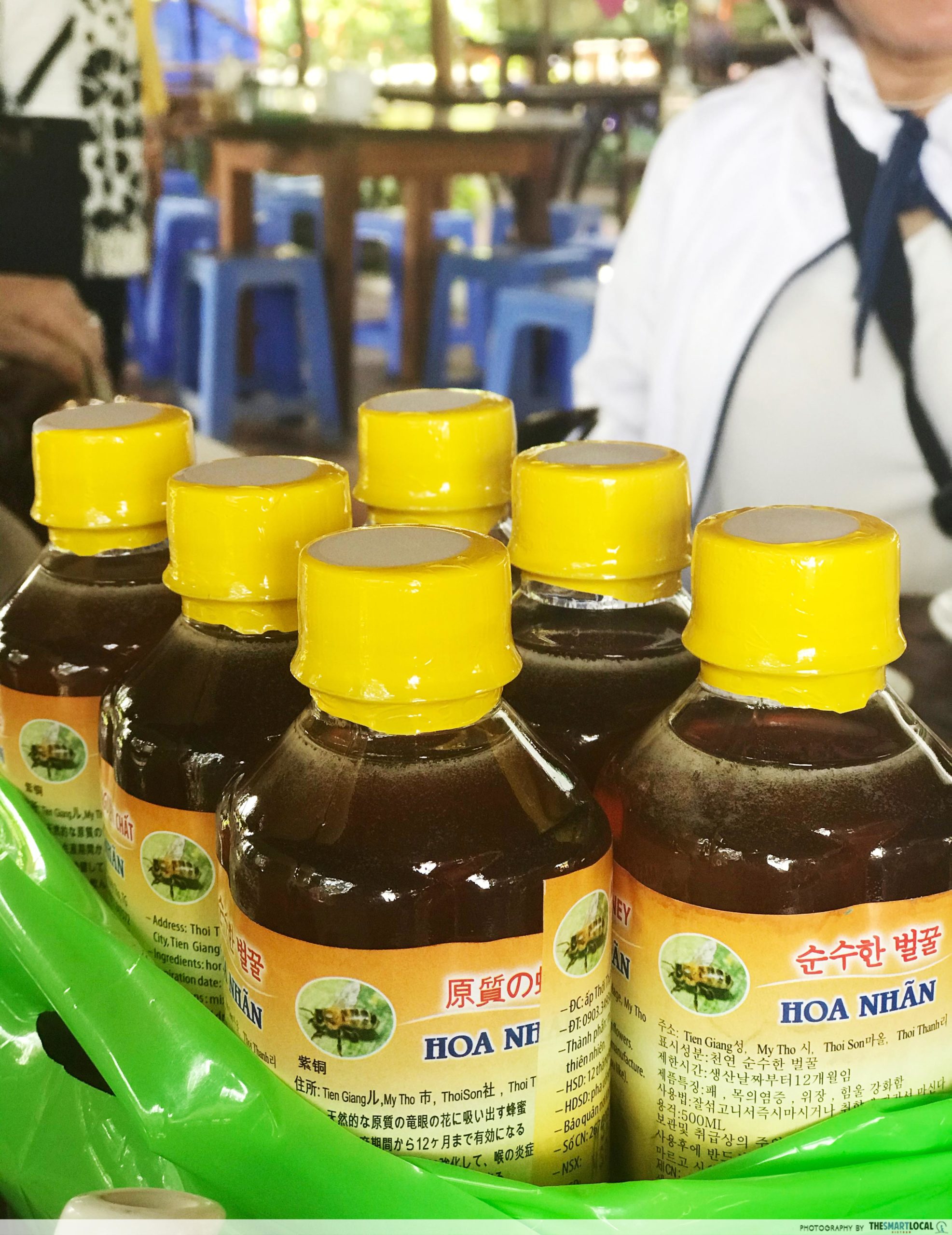
You can buy some bottled honey tea to bring home for future use or as gifts for your family and friends.
Take a stroll around the Thới Sơn village market
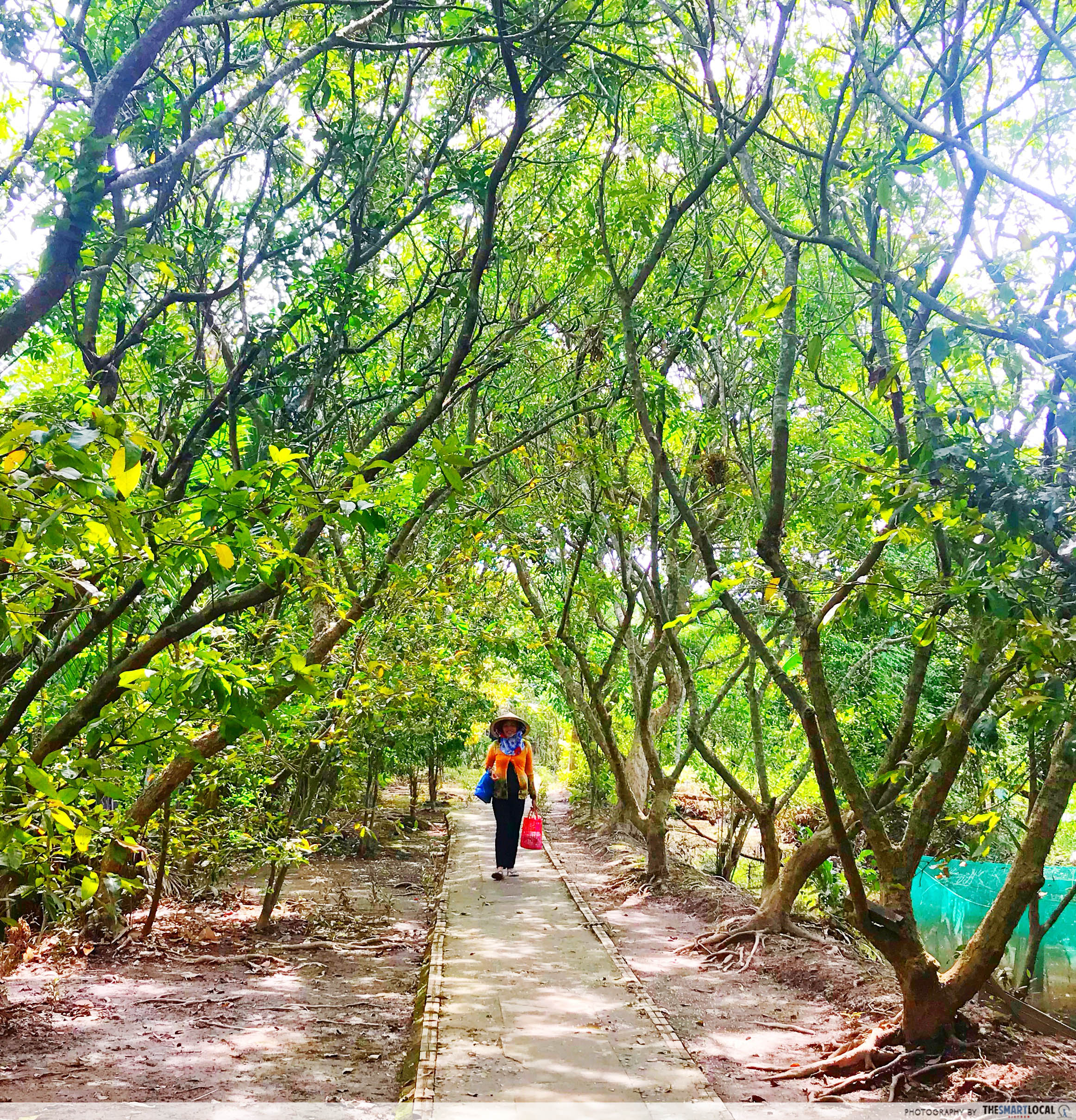
After recharging with tasty snacks, exit the house and walk further into the village on scenic roads lined with trees.
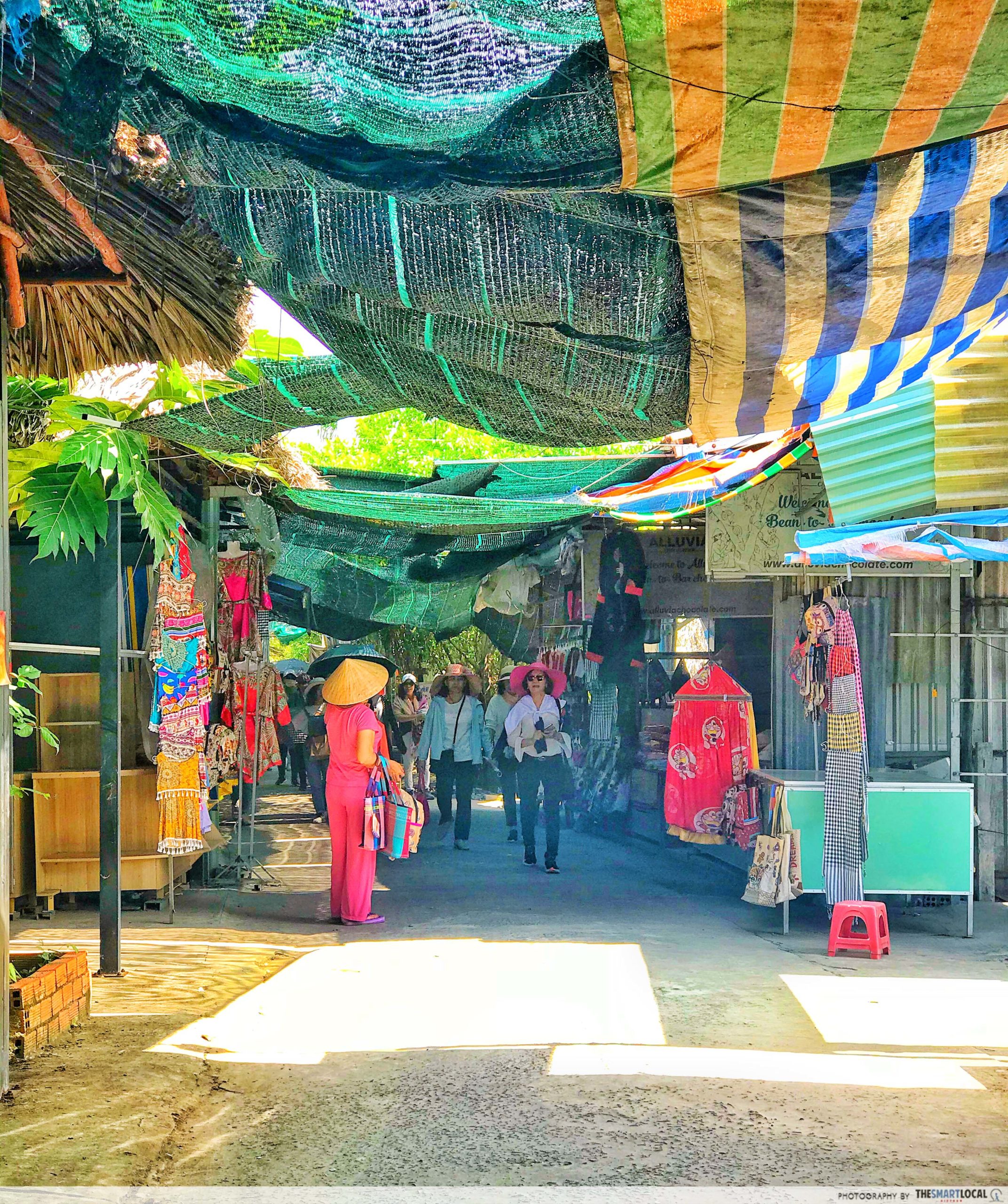
Visitors at a local market on the island
Here you’ll chance upon plenty of souvenir shops selling crafts and cone hats made of bamboo straws as well as áo bà ba and khăn rằn, the iconic garments of the ladies of the Mekong Delta Region.
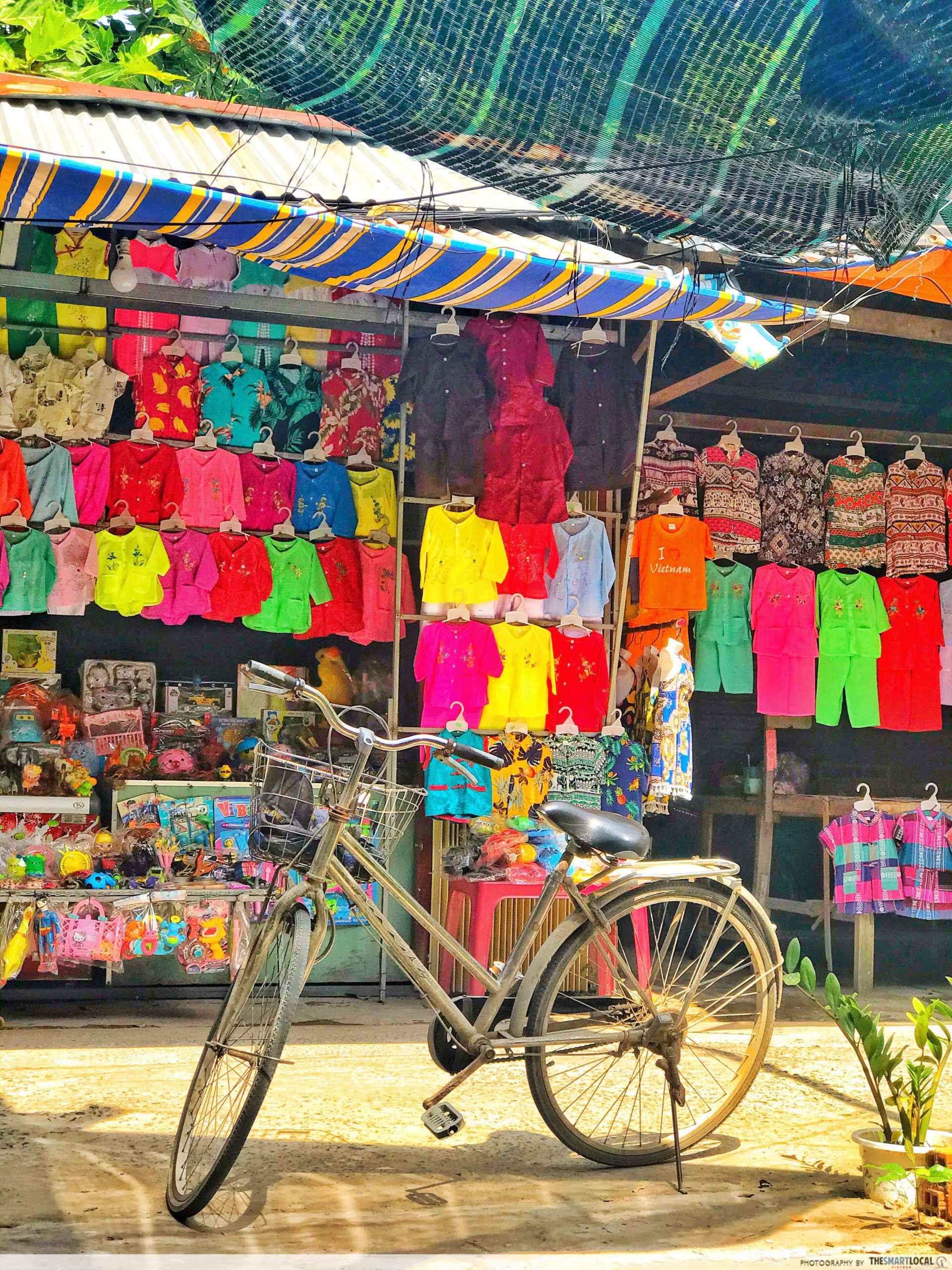
Plenty of áo bà ba for kids and adults on sale at the village market on the island
While áo dài is the staple of Vietnamese fashion for both formal and casual occasions, áo bà ba has long been a popular casual garment among the residents of the Southern countryside, especially in the Mekong Delta region.
 A woman clad in áo bà ba
A woman clad in áo bà ba
This is a long-sleeved shirt made of silk with a scooped neck, often paired with silk pants for a loose and comfortable feel suitable for casual occasions. This traditional garment is often worn by both men and women in the region.

Image credit: Tourism Can Tho
Khăn rằn, or checkered scarves that are usually in black and white, is also a traditional accessory derived from the Khmer krama and donned by the residents of the Mekong Delta Region.
Even though khăn rằn is a popular fashion accessory among the residents of Mekong Delta Region, it’s little known that the scarf itself is also a weapon used in Vietnam’s traditional martial arts, such as Takhado.
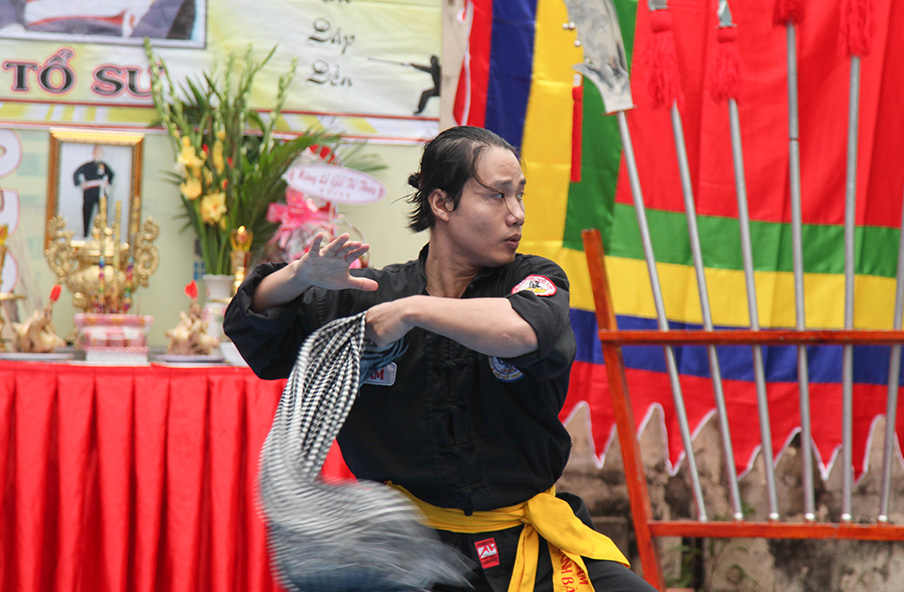
Image adapted from: Nhip Song Que Huong
Soft and long, khăn rằn can be used for both short and long-range combat using techniques such as hooking and tying opponents’ limbs to send them tumbling to the ground.
Watch live performances of Đờn Ca Tài Tử, traditional music from southern Vietnam in Thới Sơn Village
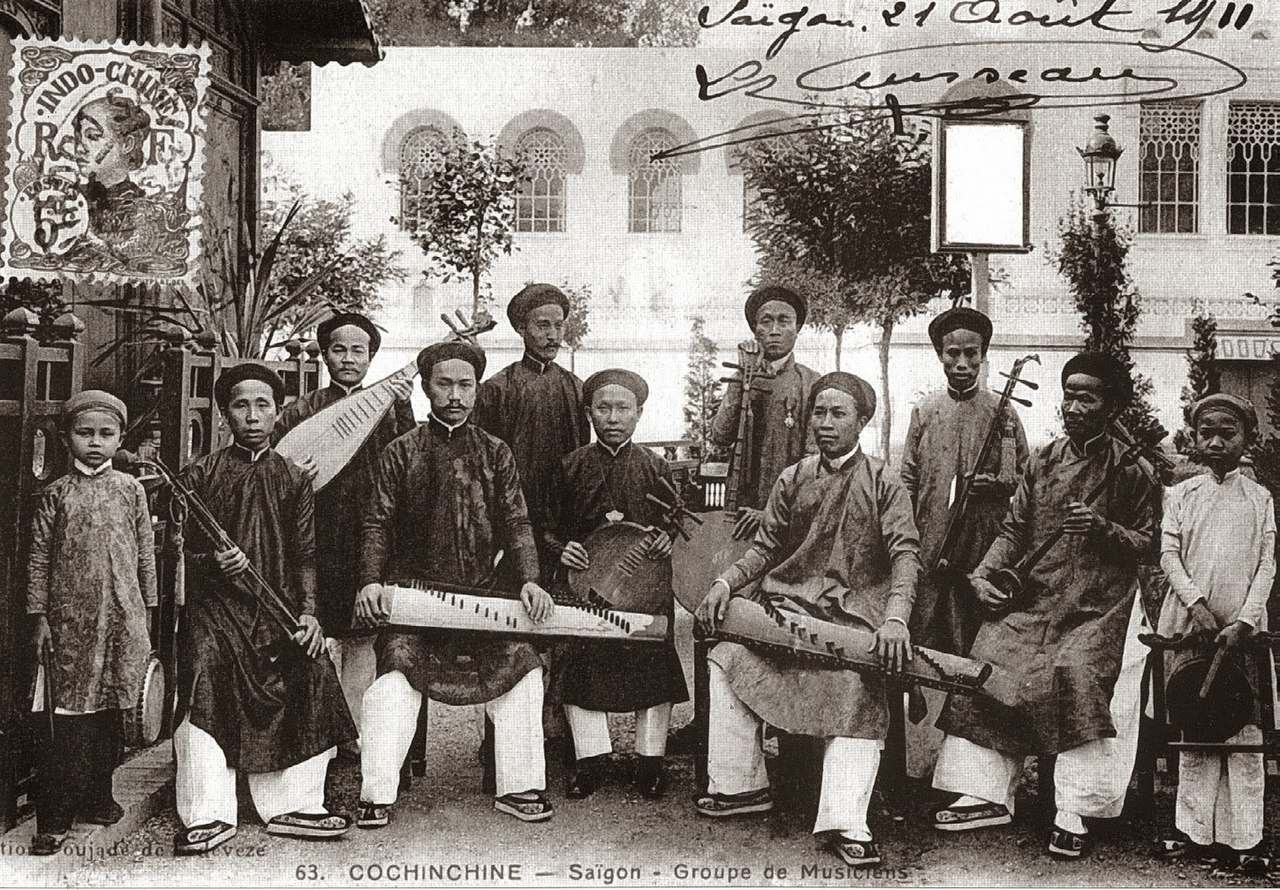
A Đờn Ca Tài Tử band in 1911
Image credit: Wikipedia
Đờn Ca Tài Tử is a famous traditional music genre in southern parts of Vietnam, especially in the Mekong Delta region.
Founded towards the end of the 19th century, Đờn Ca Tài Tử boasts a combination of Hue chamber music and folk music, using instruments such as steel guitars, violins, plucked zithers, and bowed string instruments.
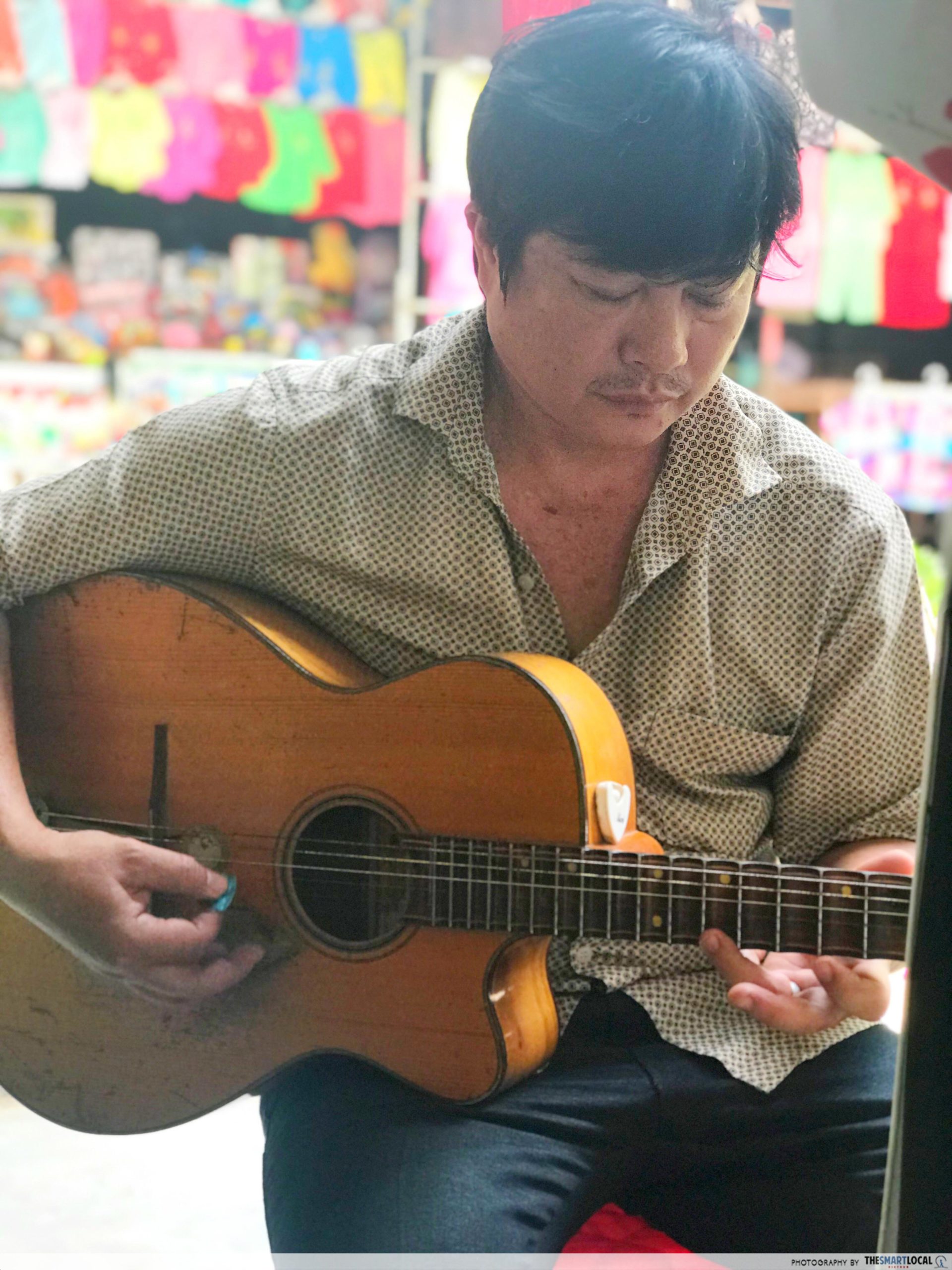
At Thới Sơn island, you’ll get a chance to watch live performances by local Đờn Ca Tài Tử musicians.
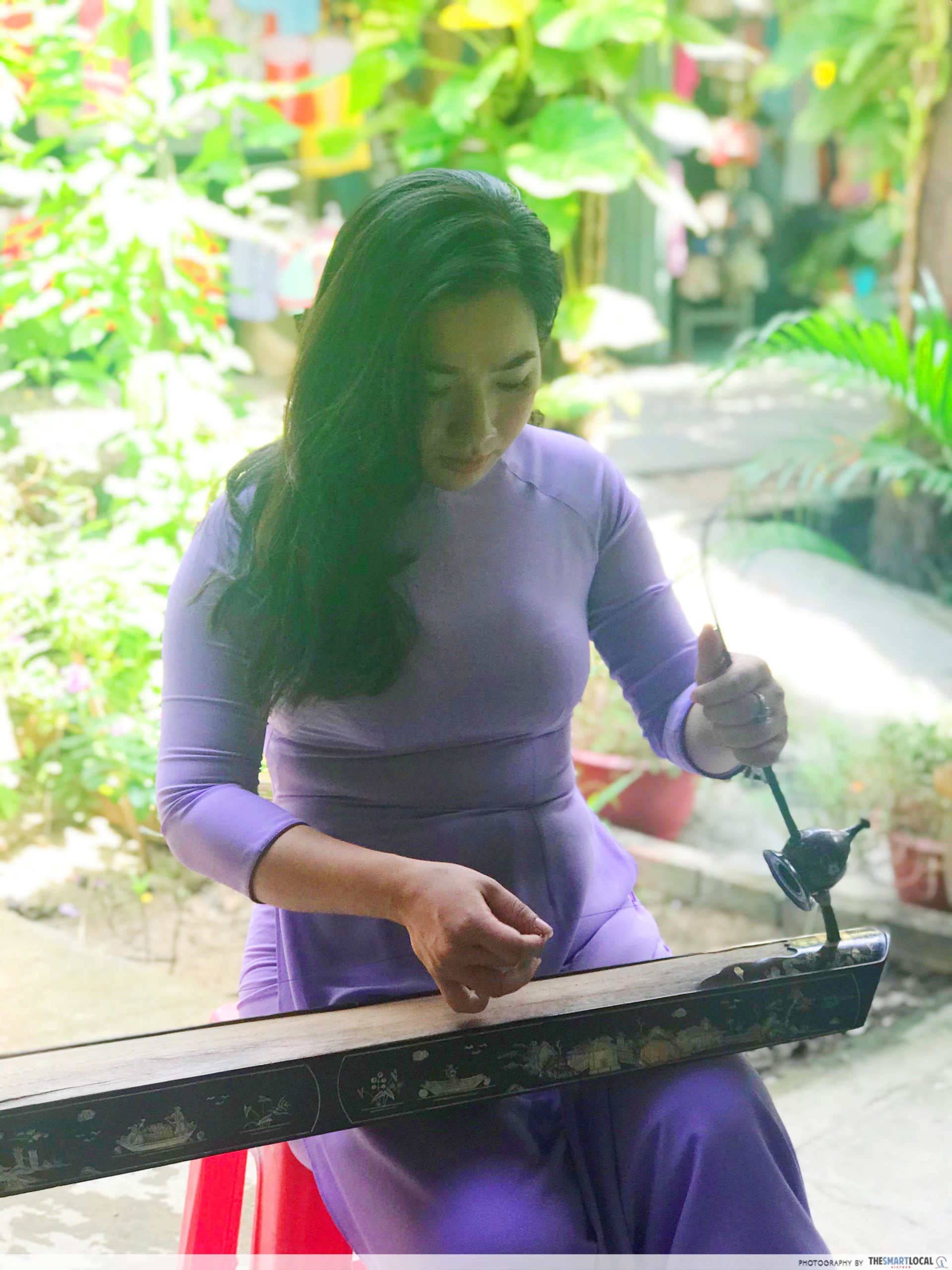
Cruise along the canals on longtail boats in Thới Sơn Island
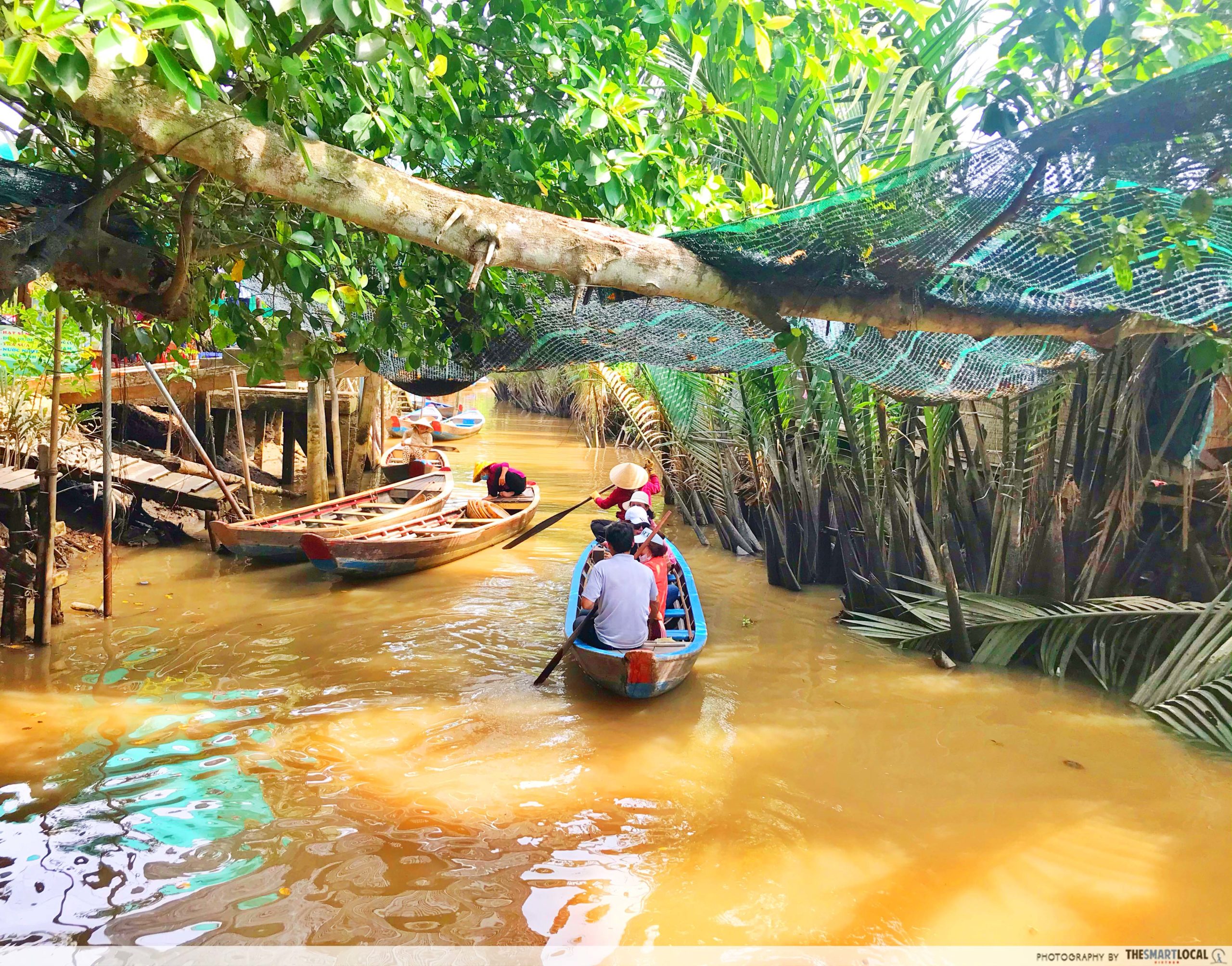
For an authentic Mekong Delta experience, a 20-minute longtail boat tour around the islands is essential.
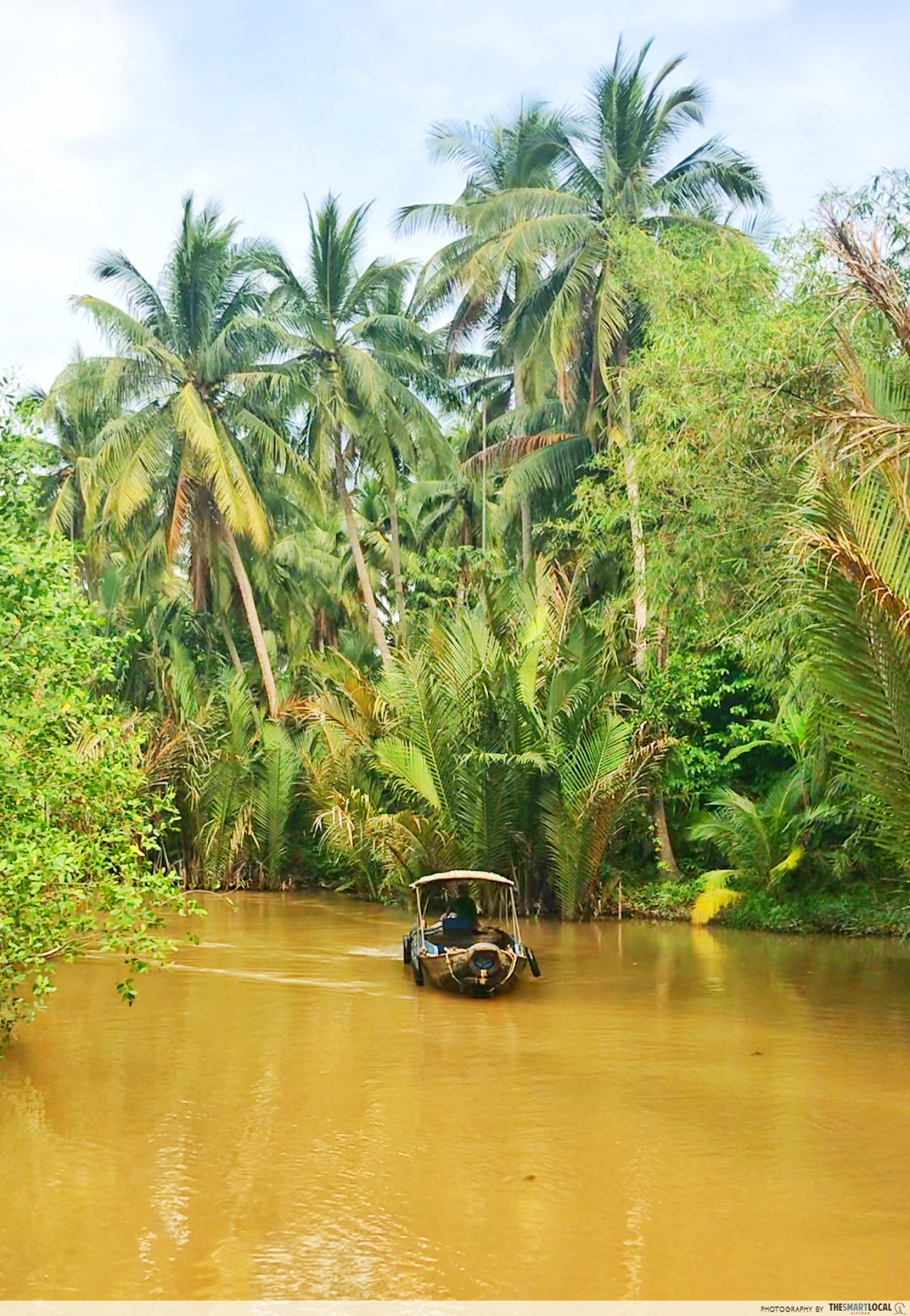
With a dense maze of canals that stretch across 1,200 hectares, Thới Sơn is the largest island in Mỹ Tho.
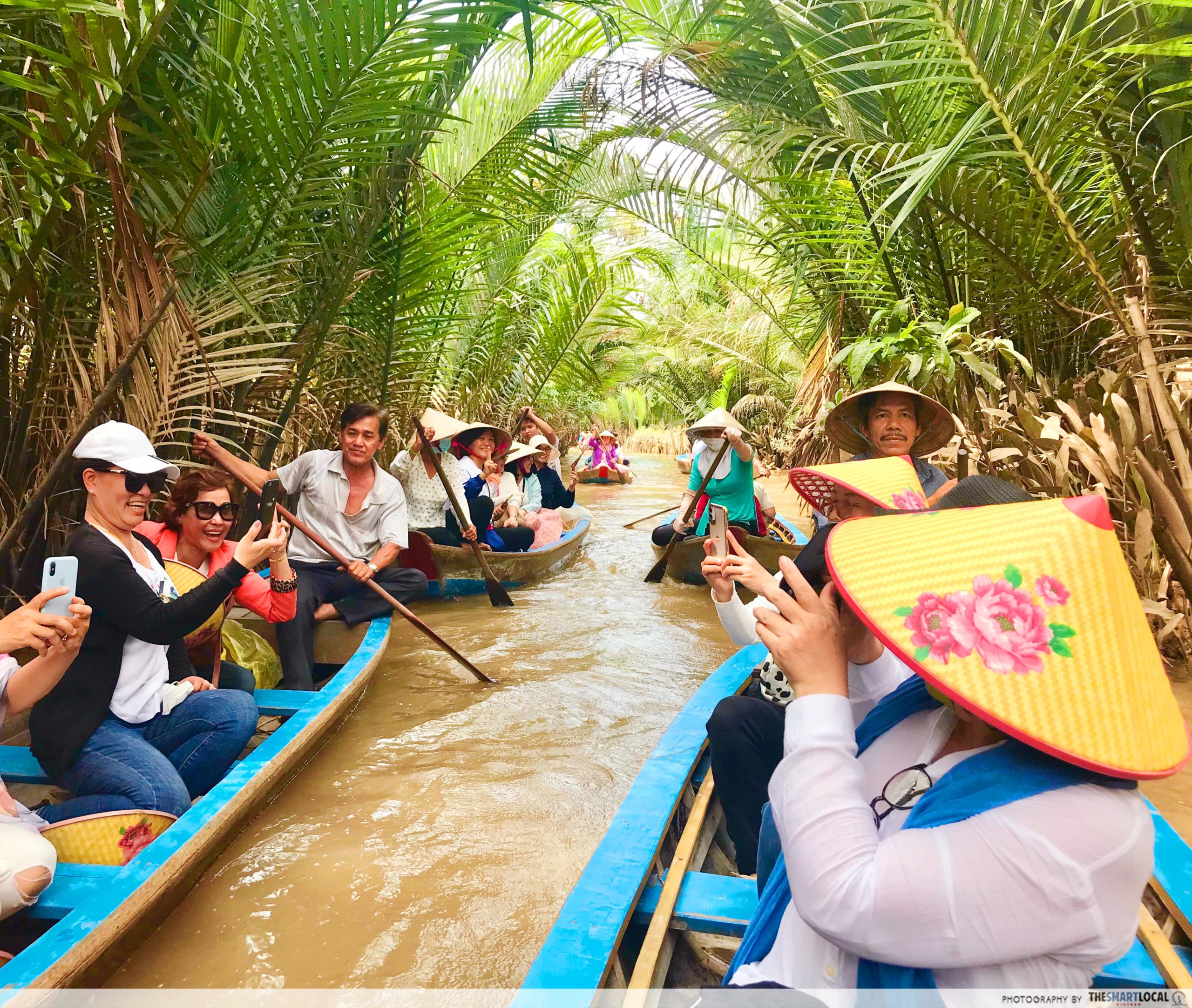
During your cruise on the longtail boats rowed by local residents, you’ll catch sight of verdant fruit gardens and luxuriant trees such as star apple trees, orange trees, and coconut trees lining the banks of the canals.
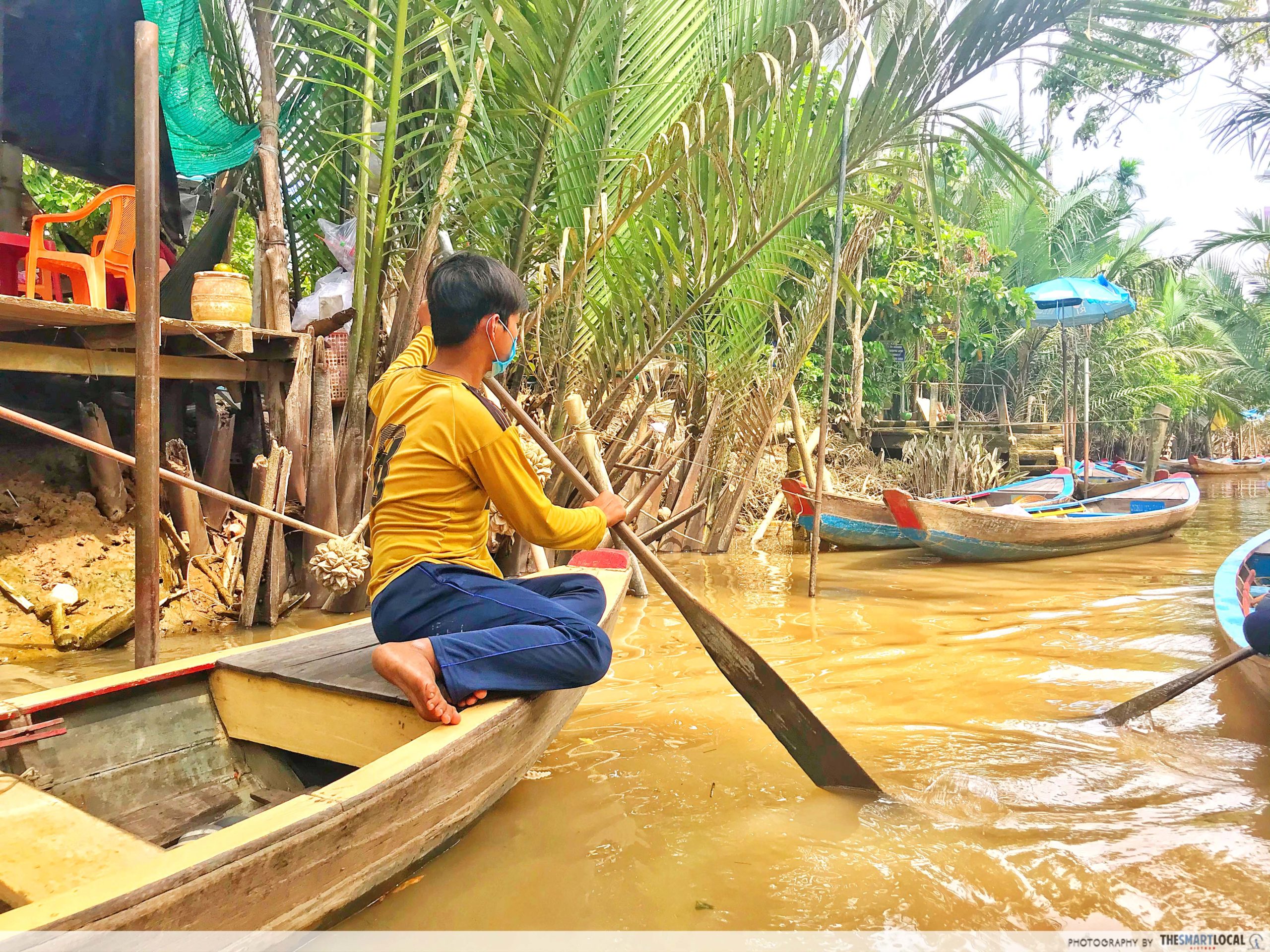
You’ll also find numerous quaint wooden houses alongside the canals where people sell snacks as well as home-cooked fish sauce.
Visit the manufacturing hub of coconut products at Hương Dừa Candy Factory
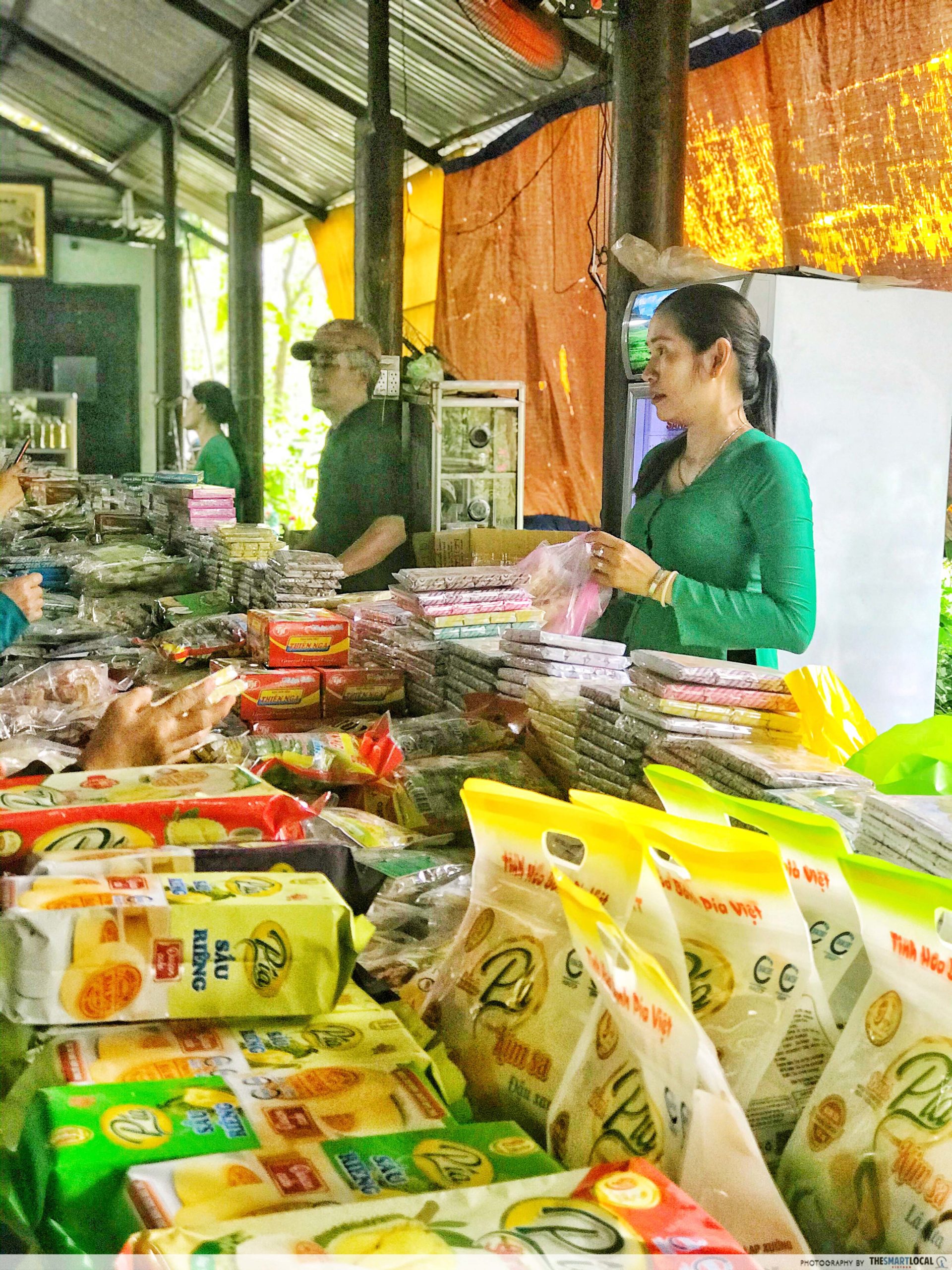
The cruise will take you back to the dock where you’ll get back on the big boats that brought you here from downtown Mỹ Tho, and which will now take you for a 20-minute ride to Bến Tre Province just across the river.
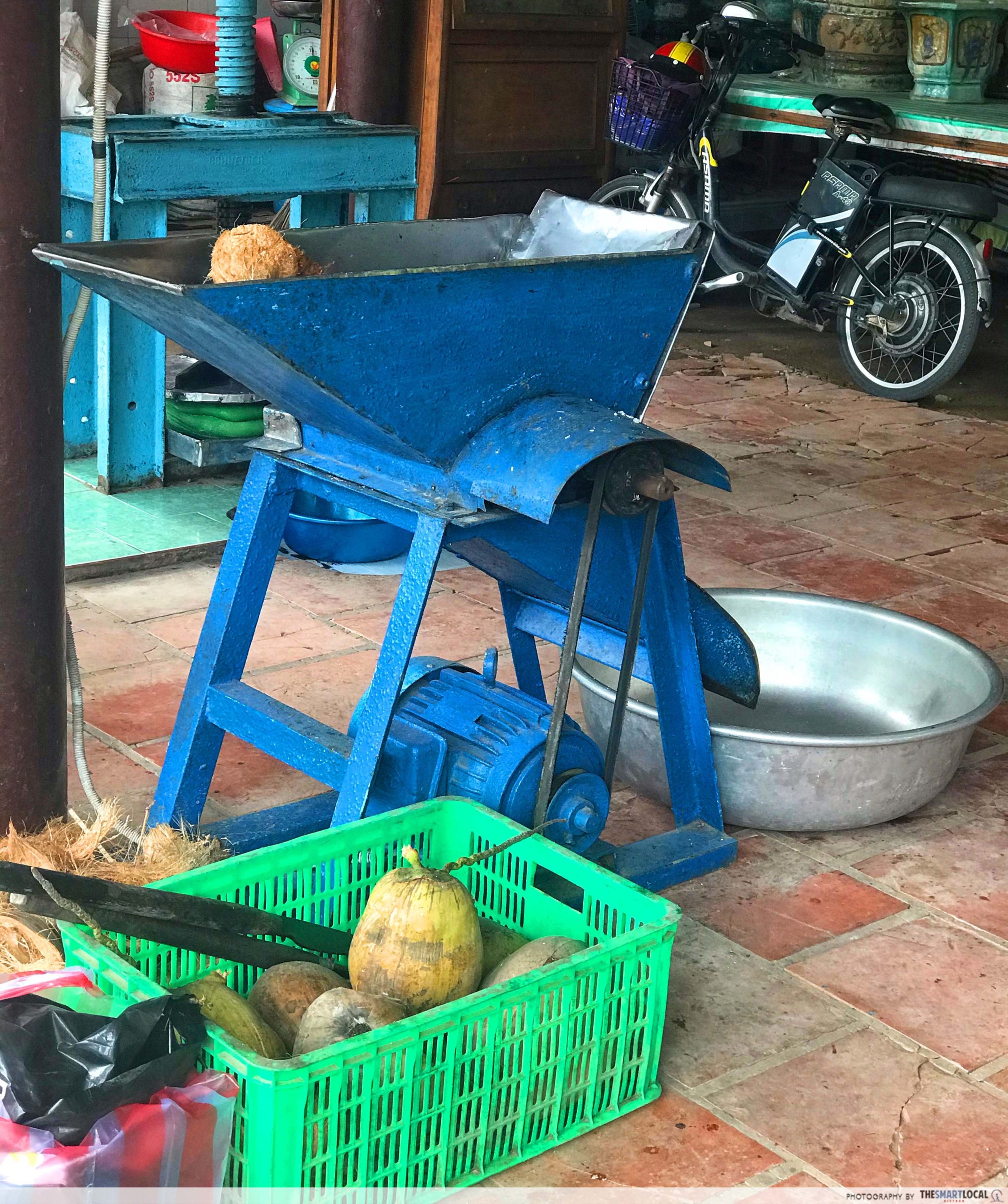
Coconut processing machine
Known as the hometown of giant coconut trees, Bến Tre is also Vietnam’s largest manufacturing hub of all manner of products made from coconuts.
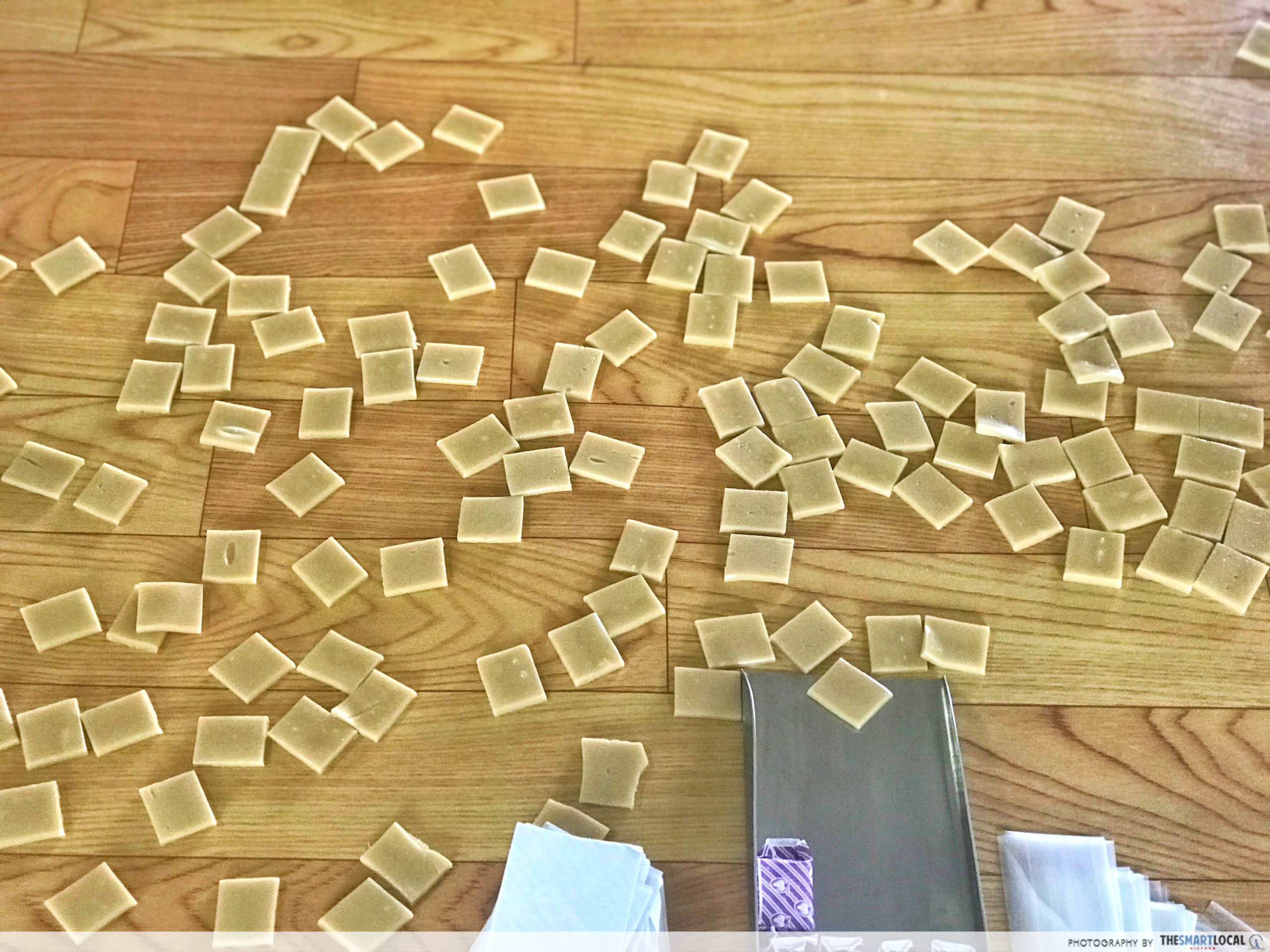
Coconut candies
The boat will take you to Hương Dừa Candy Factory (Lò Kẹo Hương Dừa), where you’ll observe the process of coconuts being crushed, made into coconut candies, and served on site to visitors.
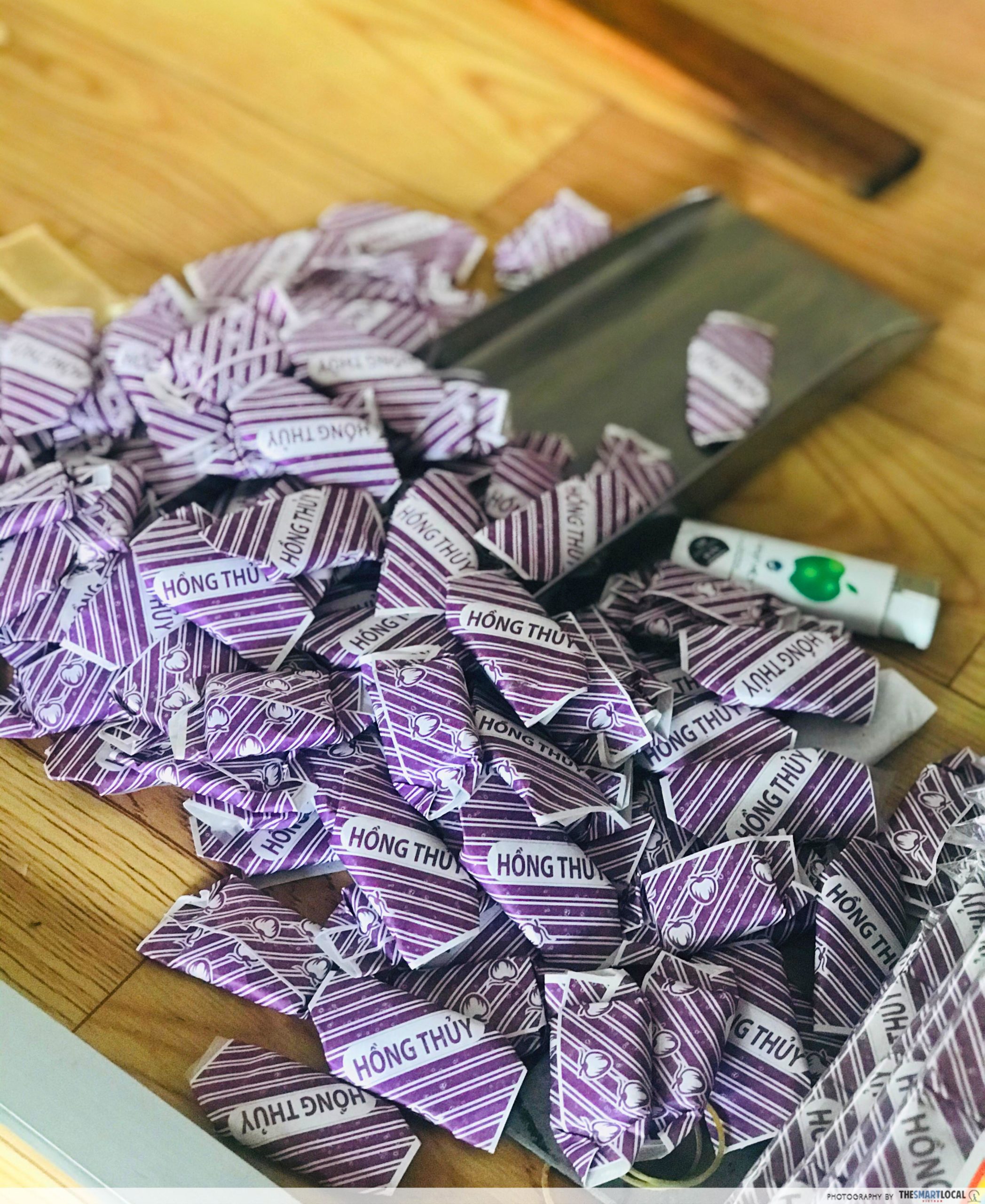 Coconut candies are among the Mekong Delta region’s specialties
Coconut candies are among the Mekong Delta region’s specialties
You’ll also find a variety of coconut oils and locally brewed wine.
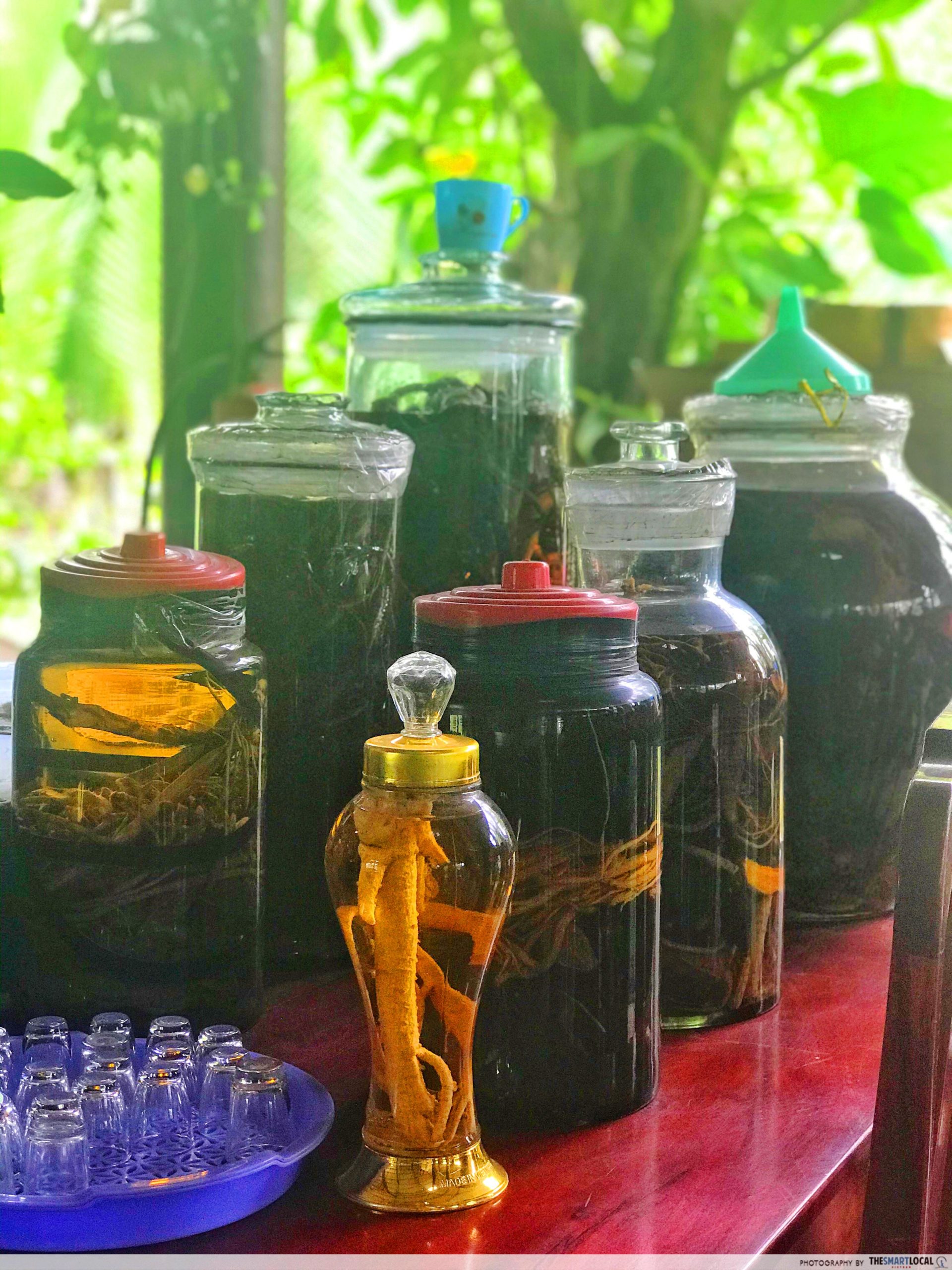
Visit the relics of the Coconut Religion (Đạo Dừa) in Bến Tre
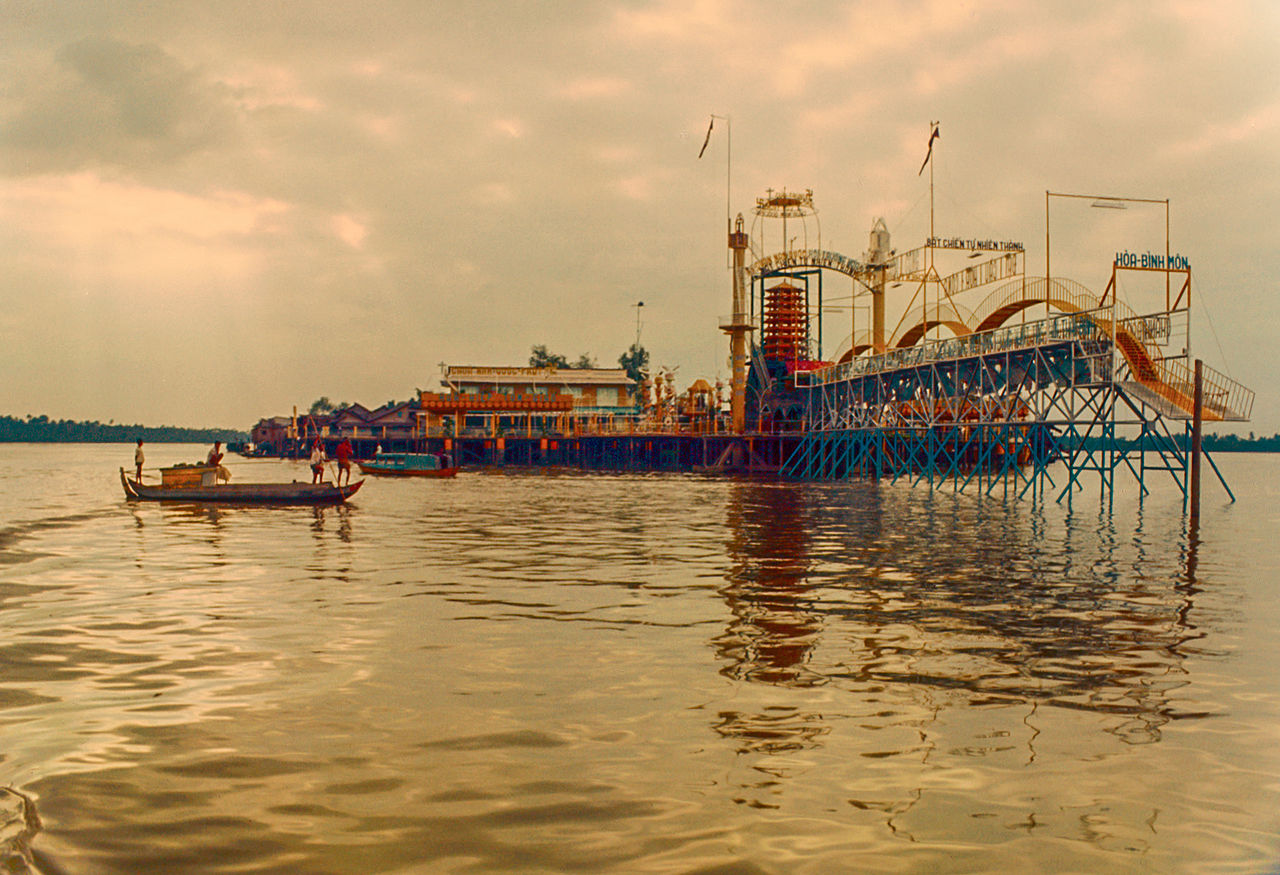
Image credit: Wikipedia
Founded in 1963 by Vietnamese scholar Nguyễn Thành Nam (1909-1990), the Coconut Religion is a unique belief system, with its cradle situated on the Phụng islet of the Mekong River in Bến Tre.
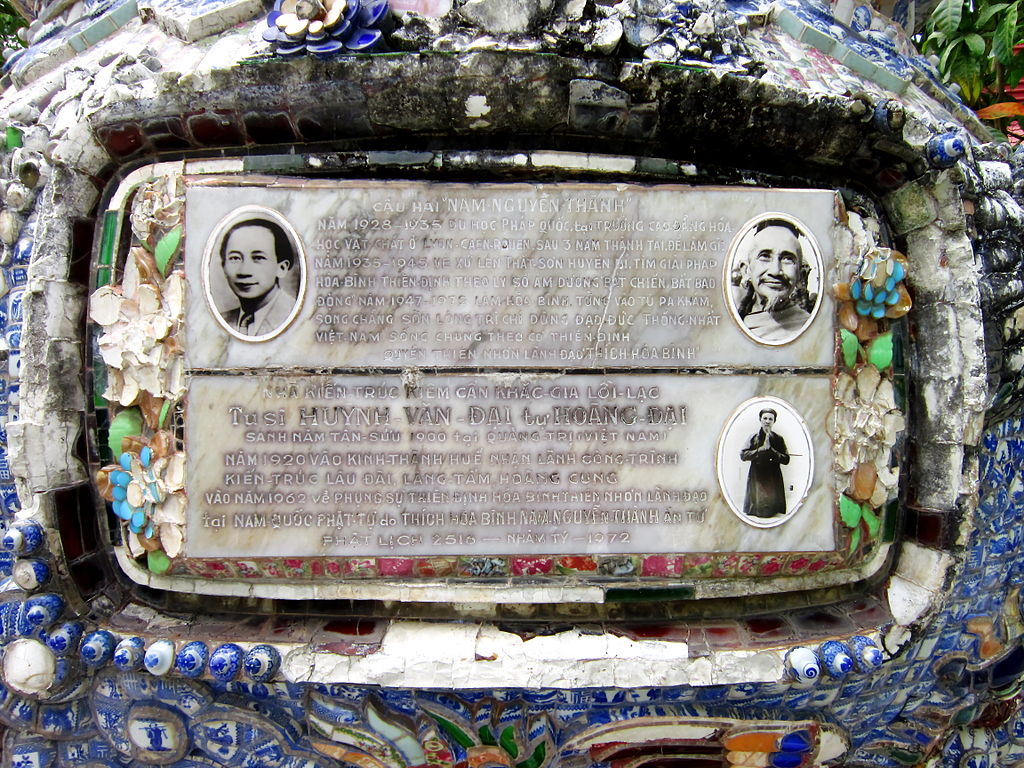
The marble memorial plate of Nguyễn Thành Nam, the founder of the Coconut Religion
Image credit: Bùi Thụy Đào Nguyên/Wikimedia Commons
Aside from combining the main principles of Buddhism and Christianity, the religion promotes drinking coconut milk and eating only coconuts.
The cult had also permitted its monks to marry 9 wives each, which raised eyebrows among the administration of the former South Vietnam in the day, and led to numerous clashes between its worshippers and authorities.
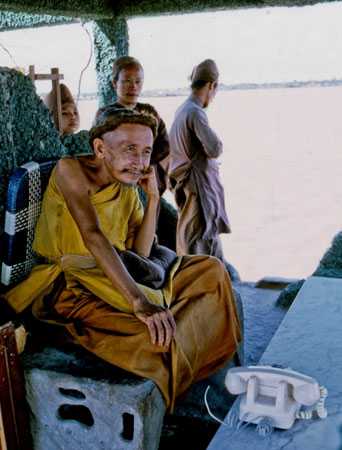
The deceased Coconut Religion founder Nguyễn Thành Nam
Image credit: VTC
At its peak, the religion garnered around 4,000 followers.
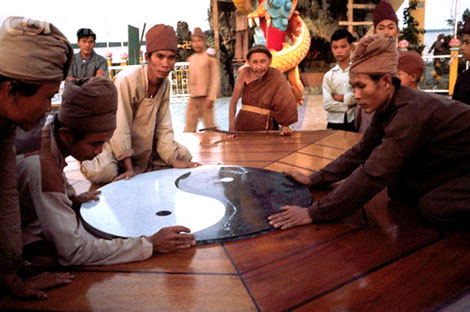
The Coconut Religion worshippers in the past
Image credit: Cong An Nhan Dan
After the death of its founder Nguyễn Thành Nam, the number of followers was significantly reduced.
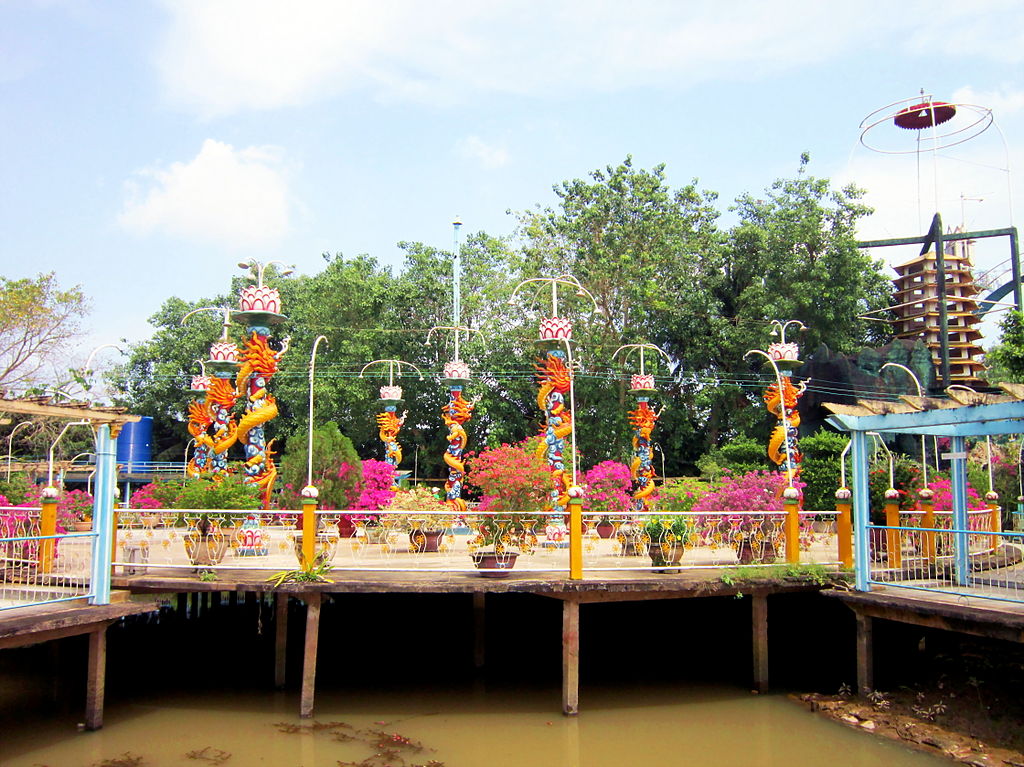
The Dragon Court
Image credit: Wikipedia
You can still visit the Phung islet estate of the Coconut Religion, which includes spacious courts decorated with dragons and a Peace Tower.
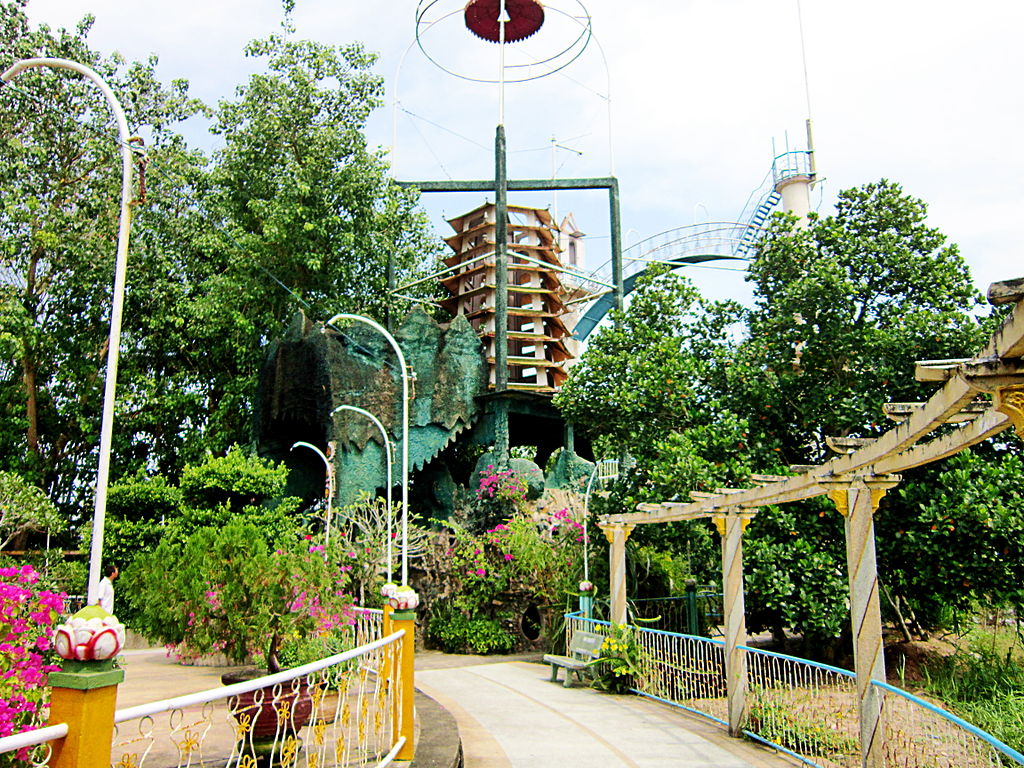
Image credit: Bùi Thụy Đào Nguyên/Wikimedia Commons
Visit Vĩnh Tràng Pagoda in Mỹ Tho
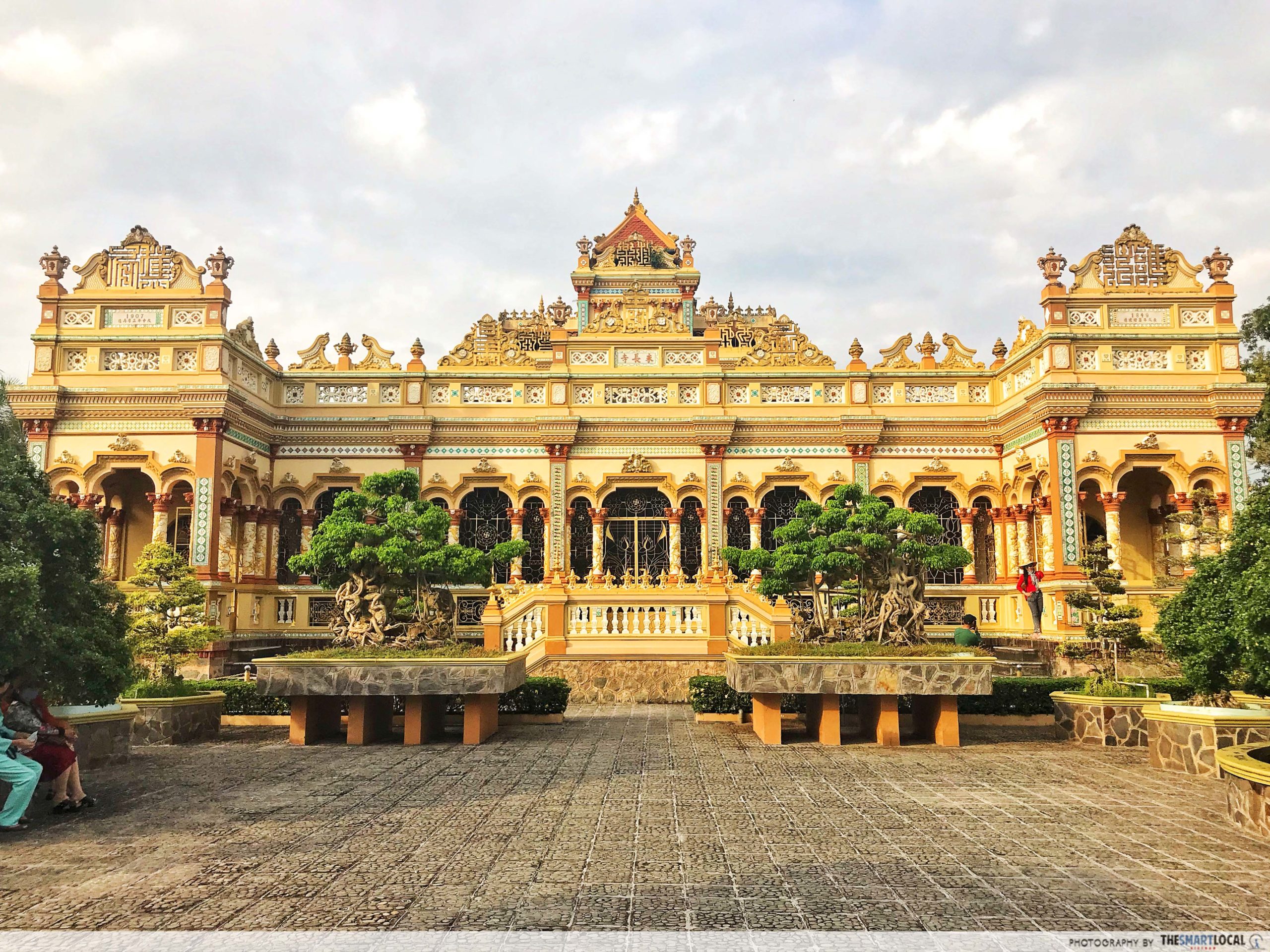
Located in Mỹ Hòa Village, Mỹ Tho City, Tiền Giang Province, Vĩnh Tràng Pagoda is among the must-visit tourist attractions in the Mekong Delta Region.
Built in 1849 during the Indochinese era, Vĩnh Tràng Pagoda is a unique work of architecture featuring French, Roman, Thai, Champa, and Cambodian design elements, using yellow as its main color.
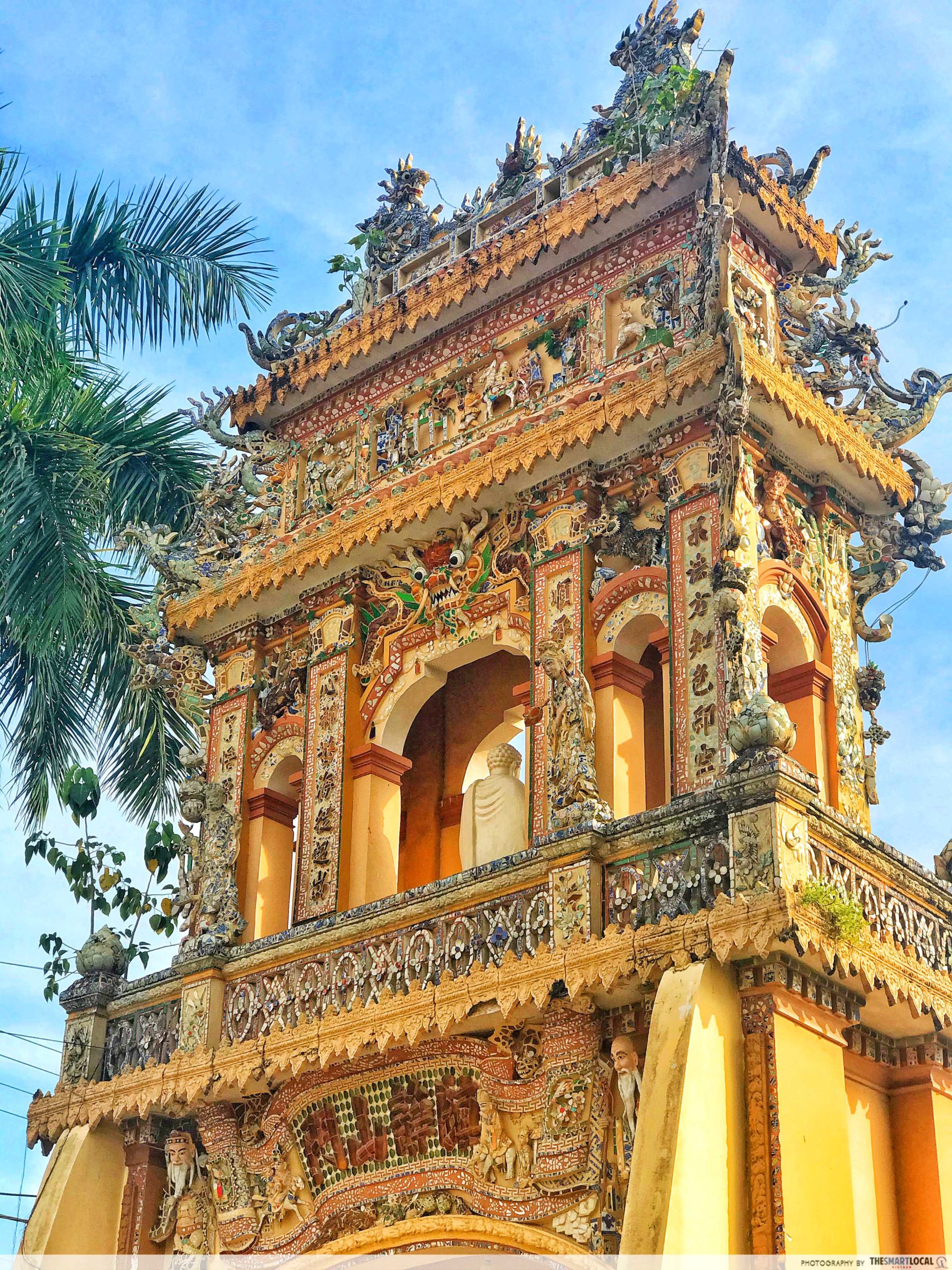
The gate of the pagoda is itself a masterpiece of art, made from broken porcelain and engraved with motifs showing Buddhist myths.
Featuring exquisitely carved work with curved sloping roofs on both sides, the design of the main hall is reminiscent of Angkor Wat’s architecture in Cambodia.
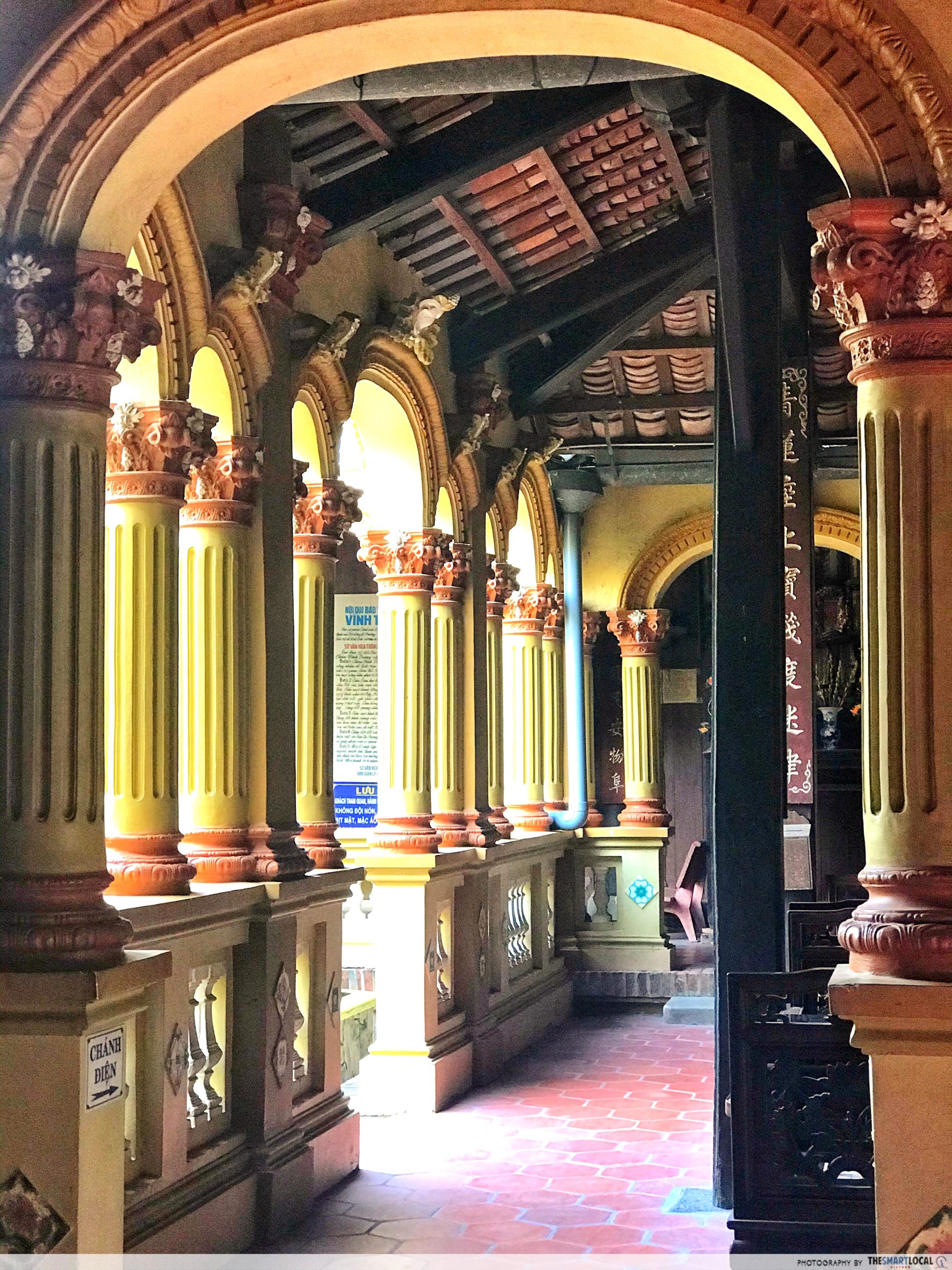
The exteriors and interiors of the pagoda, on the other hand, feature Corinthian-style columns, an iconic feature of Roman classical architecture.
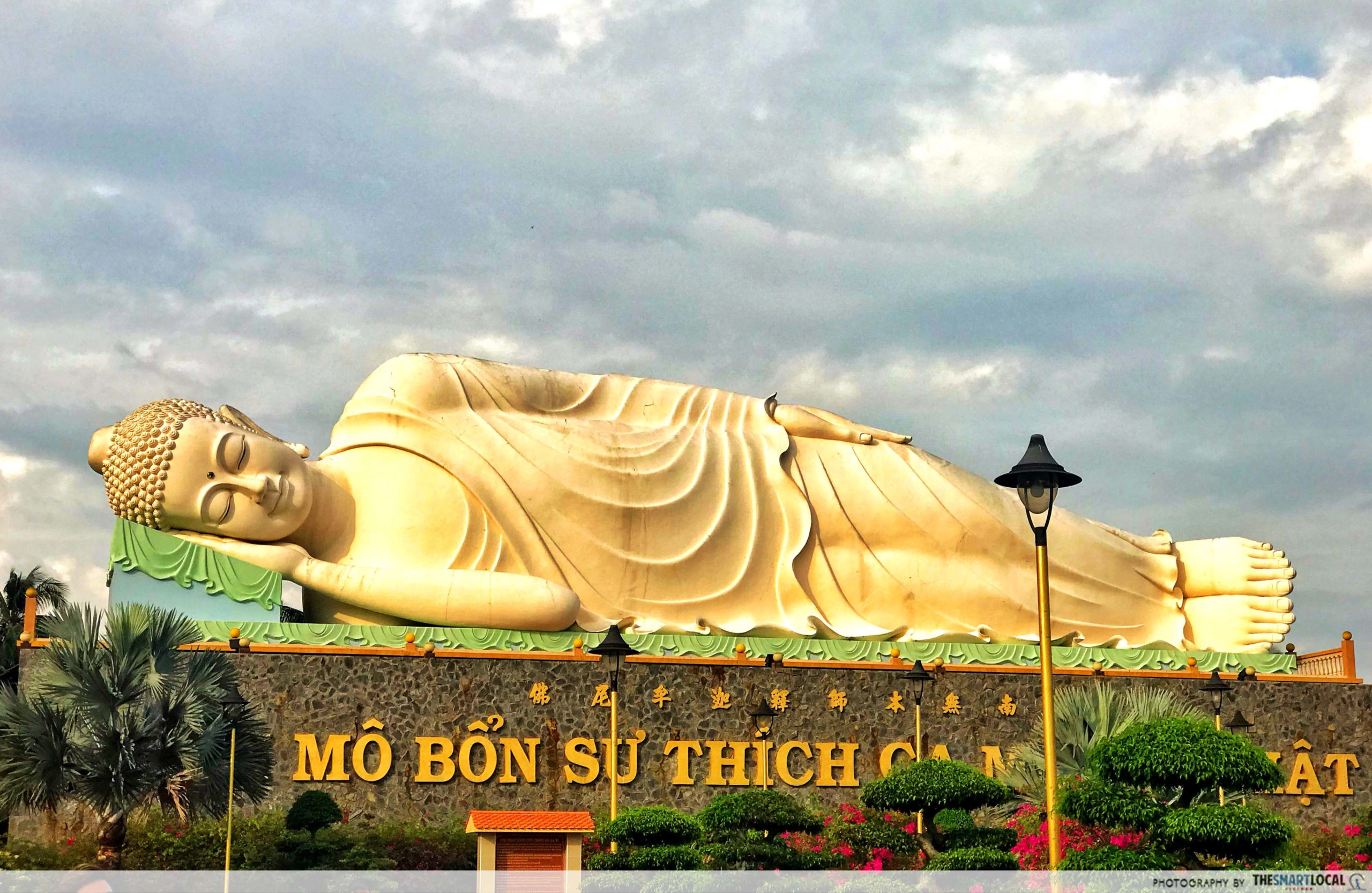
The pagoda is also a treasure trove of artifacts, playing host to 60 Buddha statues made of wood, cobble, and concrete, most of which were constructed in the late 19th and early 20th century.
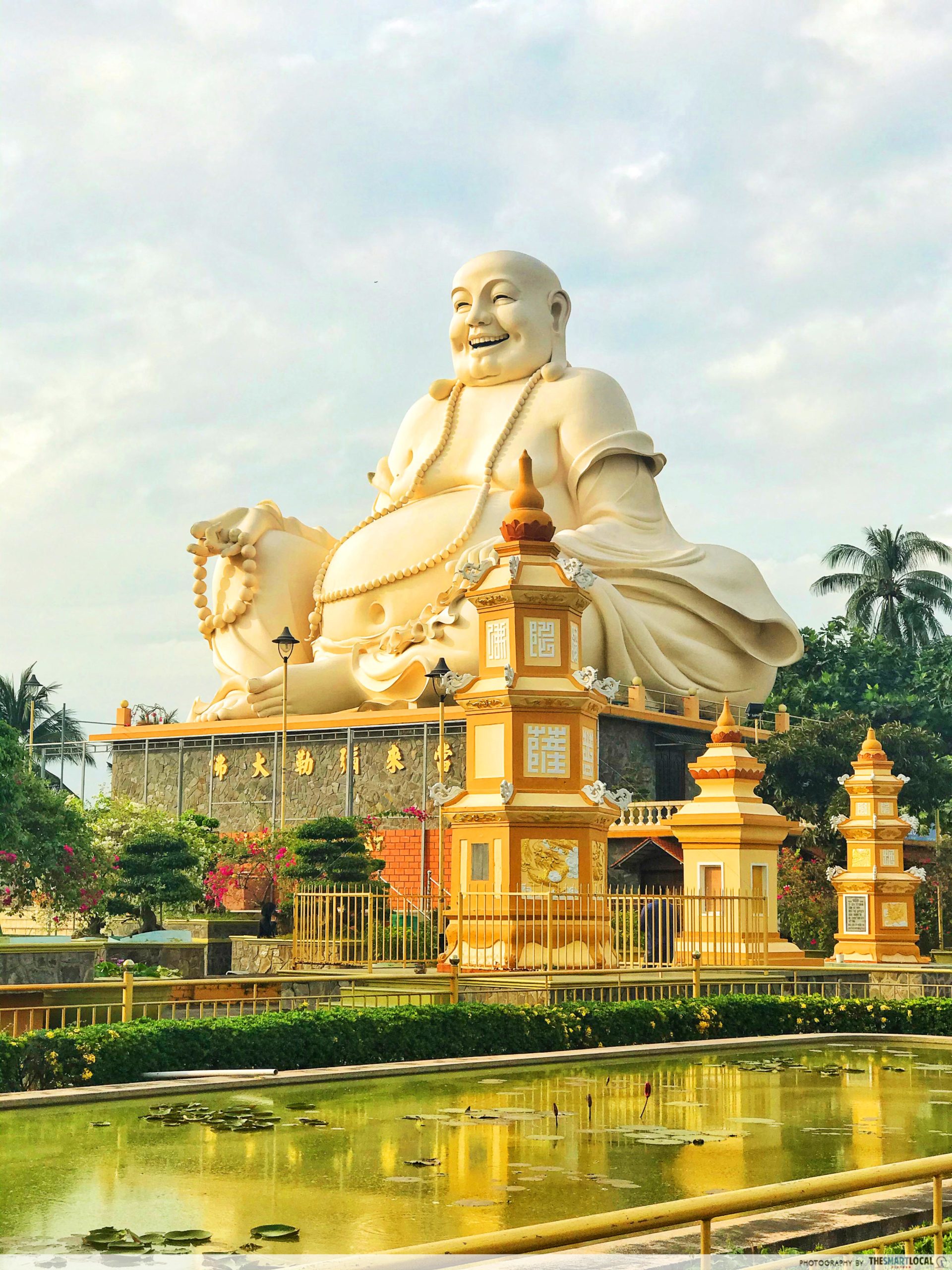
One of the most checked-in spots in the pagoda is a statue featuring the reclining Shakyamuni Buddha, a 7-tier tower, and a 20M-tall and 250-ton Maitreya statue.
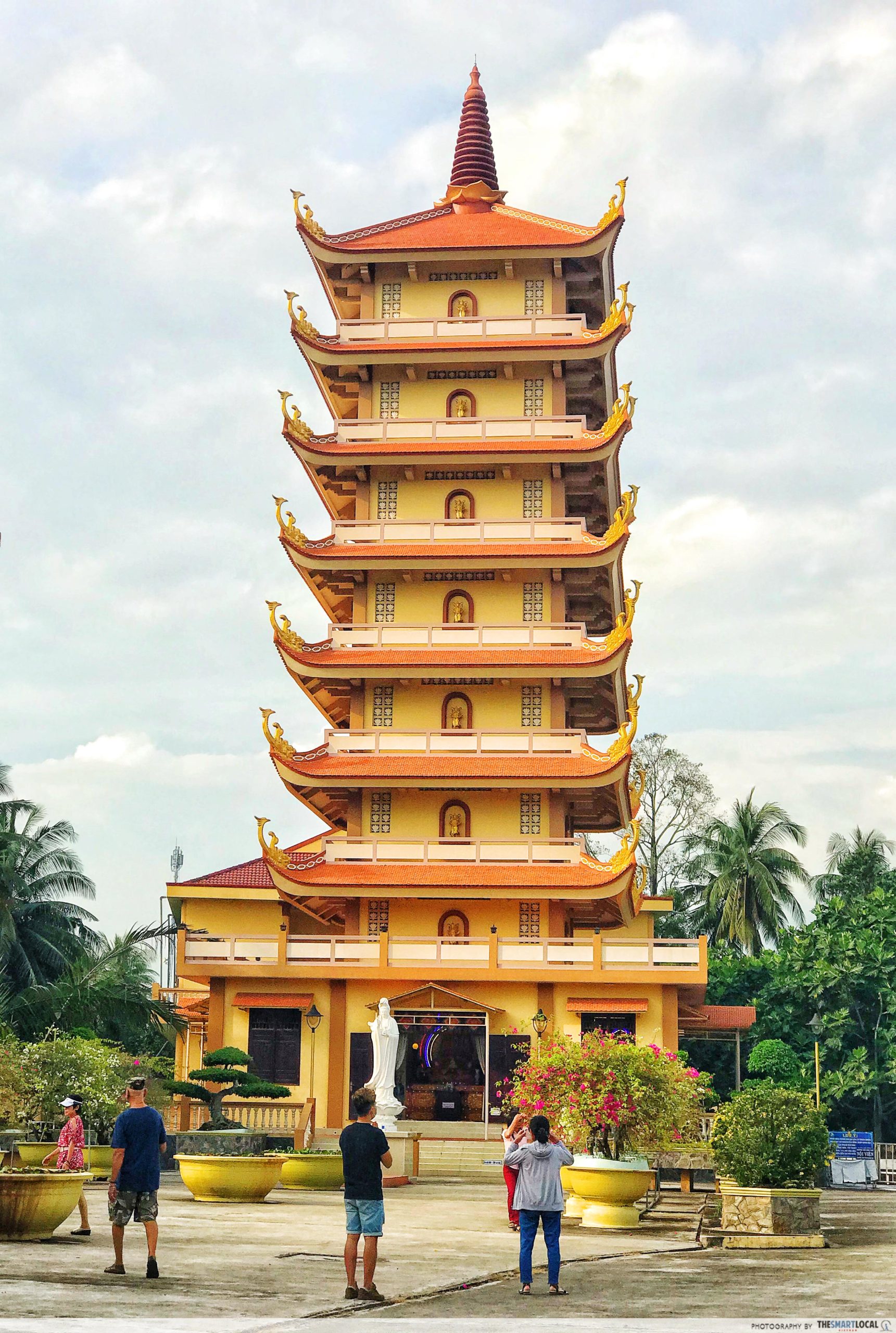
Dine at the open-air, country-style Việt Nhật Ecological Restaurant by Tân Thạch Canal
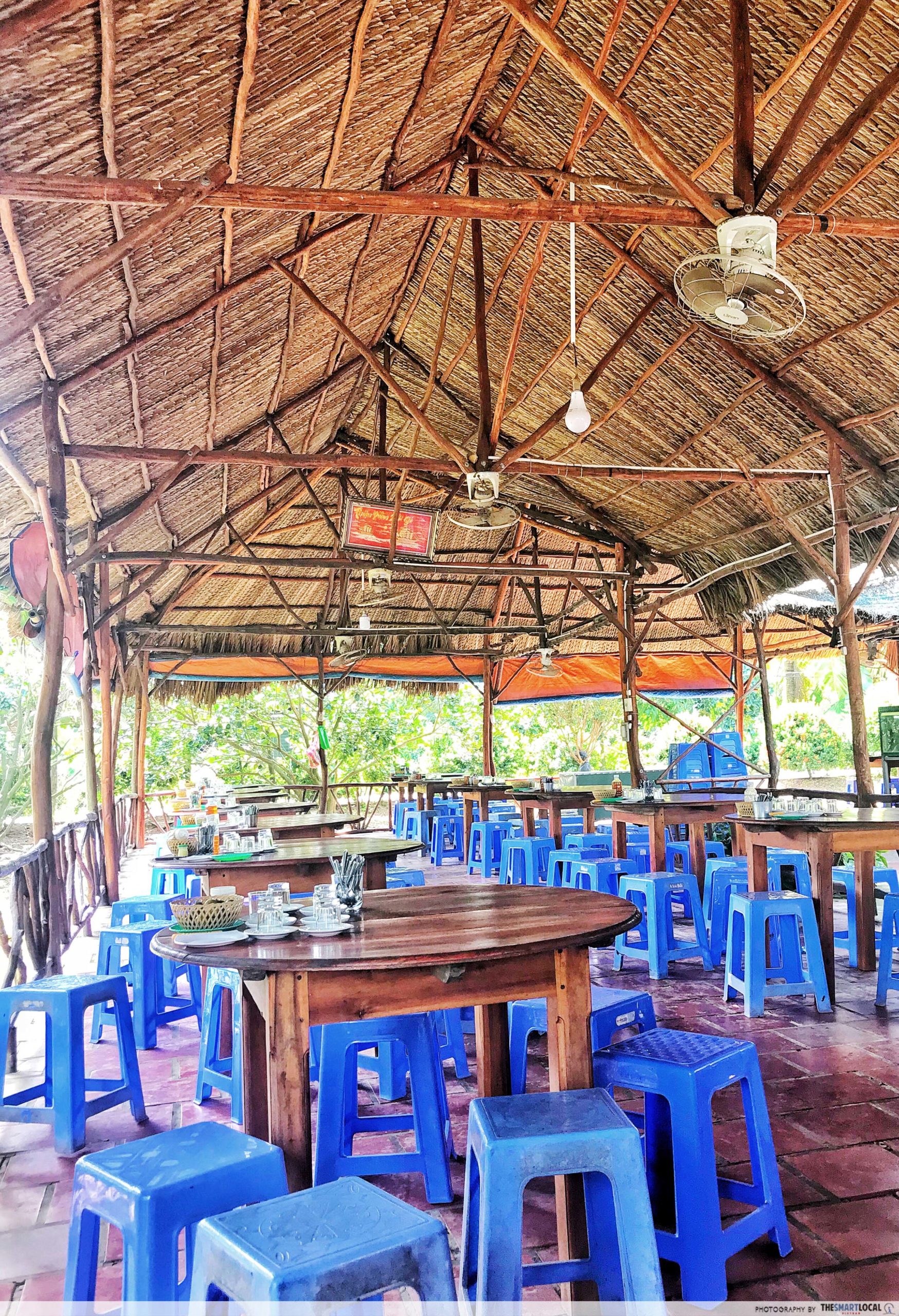
Decked out with spacious pavilions built from wood and bamboo straw, Việt Nhật Ecological Restaurant is the spot for an authentic Mekong Delta-style dining experience.
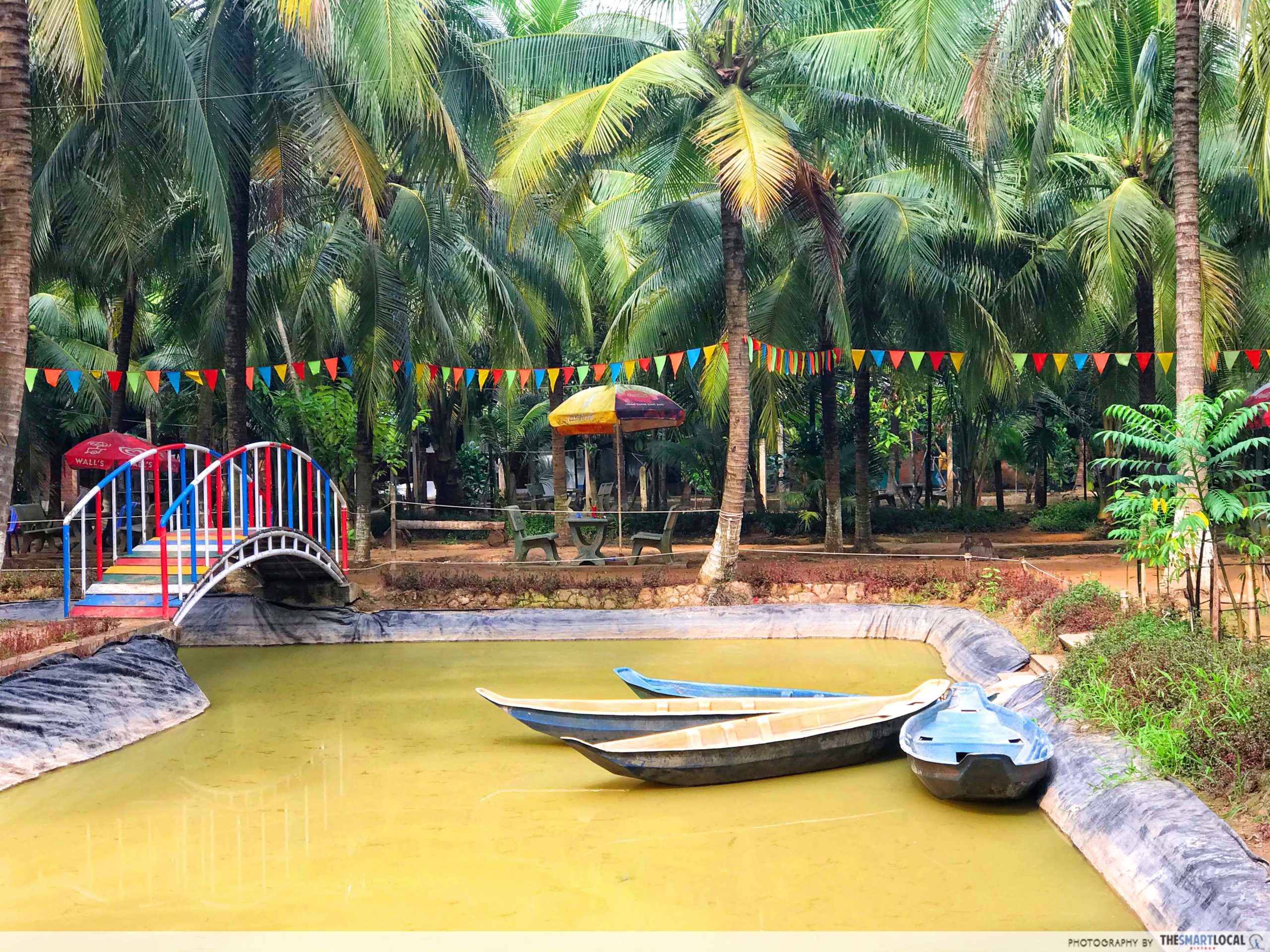
The restaurant is filled with fruit trees, flowers, ponds, as well as areas for team-building activities.
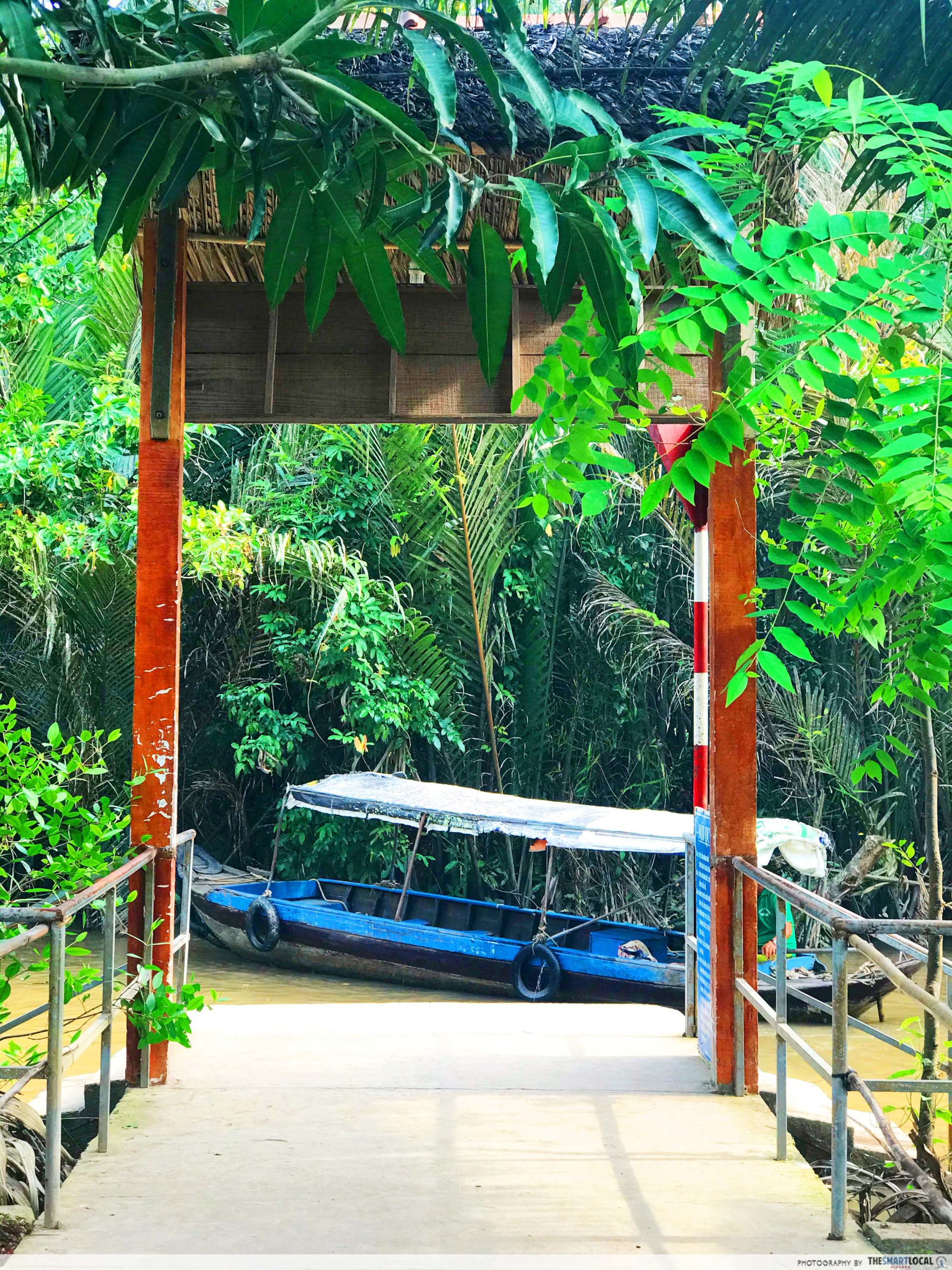
From the restaurant, you can enjoy a panoramic view over the peaceful river lined with coconut trees and charming boats sailing back and forth.
Things to do in Mỹ Tho and Bến Tre
Filled with lush greenery and traditional architecture, a trip to the Mekong Delta will offer great insights into the region’s rich cultural and historical heritage.
Within one to two days, you can experience a universe of excitement with breathtaking boat tours, eye-opening Vietnamese traditional art shows, and delicious specialties.
Also check out:
- 8 beaches & Islands near Saigon for a fuss-free getaway trip
- Guide to Dai Nam Wonderland, Vietnam’s largest cultural theme park
- 20 camping sites across Vietnam for exhilarating outings
- 20 natural attractions around Vietnam for thrilling outdoor activities
- Saigon Zoo Guide: Things to do
- 9 riverside cafes and restaurants in Saigon for a chill weekend dinner
Cover image adapted from: The Smart Local Vietnam
Enjoying The Smart Local Vietnam? Follow us on Facebook, Instagram, Telegram, and LinkedIn for more stories like this.
